Regency Tidbits
Domestic Life
Widows
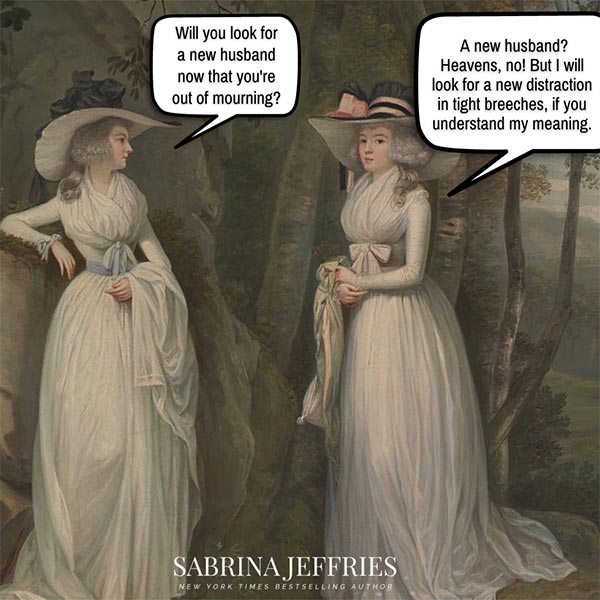
You may remember that Eliza Harper Pierce, the next sister to gain her hero in this series, is a widow. One member of Sabrina’s Dames and Dukes asked what privileges widows had that unmarried ladies didn’t, so I thought I’d answer that. For one thing, Society looked the other way when a widow took a lover, as long as she was discreet. Nothing illustrates that more than a biographical sketch in the February 1810 La Belle Assemblee (page 59; read it for yourself here). It touted the Duke of Devonshire’s new wife, Lady Elizabeth Foster. What it didn’t mention was that Devonshire had made an honest woman of Lady Elizabeth after she’d been his mistress, living in his household as his wife’s closest friend, for decades. The first half of that time she was separated from her husband, and the second half, she was widowed. La Belle Assemblee mentions her only living son by her first husband, but doesn’t mention her two additional illegitimate children by the duke. She must have been discreet enough. Or perhaps the fact that her new husband was a duke was the deciding factor!
Calendar Houses
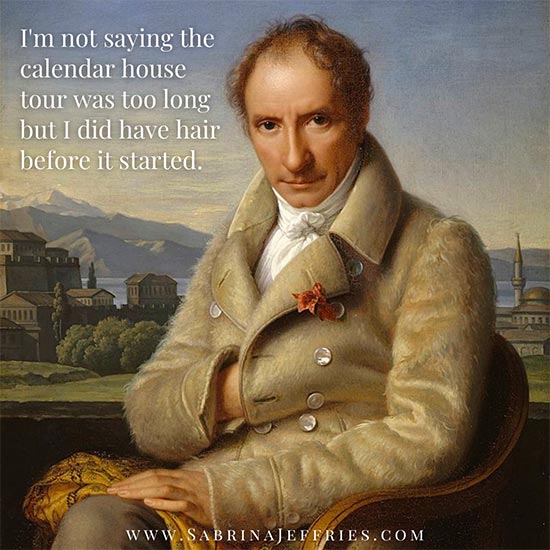
Halstead Hall is inspired by Knole in Kent. Both are calendar houses, which means their elements come in numbers you’d find in a calendar. Knole has 365 rooms, 52 staircases, 12 entrances, and 7 courtyards. How does an owner even keep track of 365 rooms? Knole was once a palace, and many of its 17th century elements and furnishings have been preserved, which is understandable. While all the other lords were fixing up their grand country houses in the 18th and 19th centuries, I’m sure the lords who lived in Knole (there were several) couldn’t face the daunting task of renovating such a huge mansion! Anyway, I have pics of Knole on my Pinterest page for Hellions of Halstead Hall, if you’d like to see it. Or, since the National Trust now owns the place, you can go here to get a brief history and see some pics. Meanwhile, below are some lovely paintings of the house from the Victorian period.
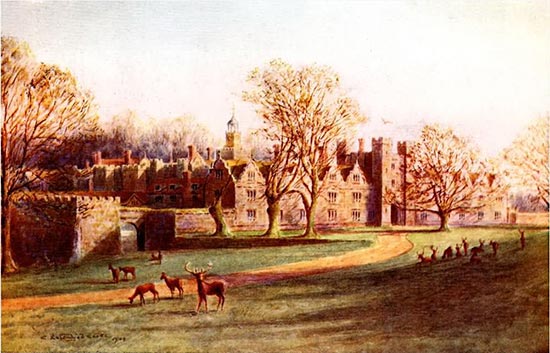
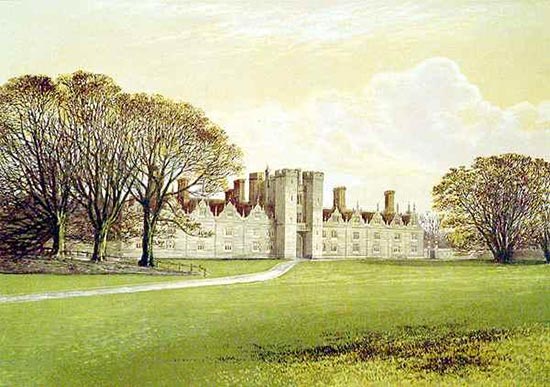
New Orleans Creole
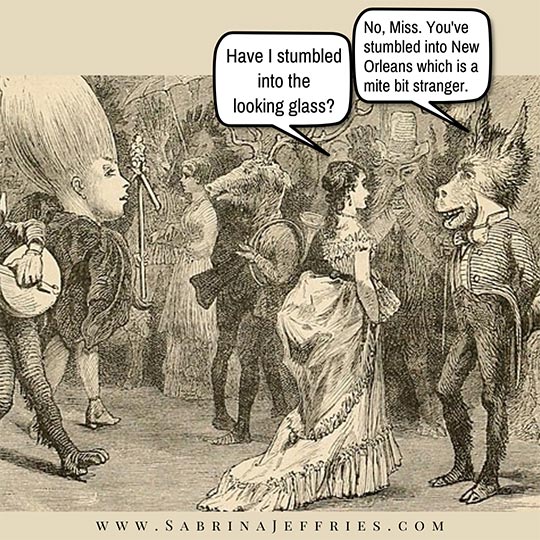
You may not know this but my husband is a New Orleans Creole, with his family going back more than two hundred years in Louisiana. One of his ancestors is Bernard de Marigny, who lived in New Orleans during our beloved Regency period in England. A wealthy Creole landowner, Bernard had so many offspring by his mistresses that he named a street “Good children” (Rue Des Bon Enfants, later changed to St. Claude). He also invented craps, the dice game, which is based largely on hazard, the British dice game, which he learned while spending time in England. But my husband has the only blue blood in our family, I’m afraid. I’m a mutt with Cajun, Irish, and English (or possibly Welsh) blood, and who knows what else!
All Sizes
Lady Diana Harper, the heroine in my new Designing Debutantes series, is statuesque (which I always wanted to be, but I’m too short). In her case, it means she’s not only tall but shapely. We have many misconceptions about history, but one of the biggest ones is that people were, as a general rule, thinner than we are. As Loretta Chase pointed out in a talk at a writer’s conference, we look at period garments and think, “Oh, how thin they were. Look at how small their waists were.” We extrapolate from that to assume that all Regency women were that small. What we don’t consider is that the gowns most often kept by women were their debut or wedding gowns, which come from periods in our lives when we’re at our smallest. Their everyday gowns were repurposed to make them more fashionable or handed down to the servants, who handed them down to the rag and bone shops. So we don’t get as many examples of the typical gowns of a matron. But all you have to do is look at a few satirical prints from the period to see plenty of women of all sizes, with big bottoms or thick waists or small breasts. (Check out this famous one by Thomas Rowlandson.) People are people, regardless of the historical period.
Conservatories
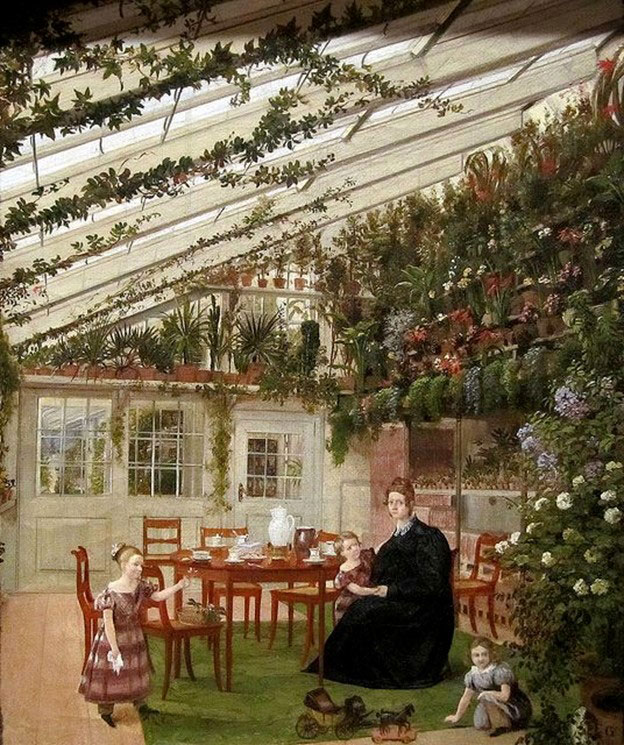
Many country houses had conservatories, but they could be as different as the families who lived there. The one pictured has lots of plants and plenty of space for socializing. Some had only a few plants; some were like inside forests. It was a way of nurturing exotic plants year-round, since essentially conservatories were greenhouses attached (sometimes) to the main houses. We’d probably call them sunrooms now. If you’d like to see a large detached one, check out the pics on my Pinterest page (Regency Tidbit board) for the one at Syon House. I’ve been there! It was built right around the Regency period.
Origin of Names
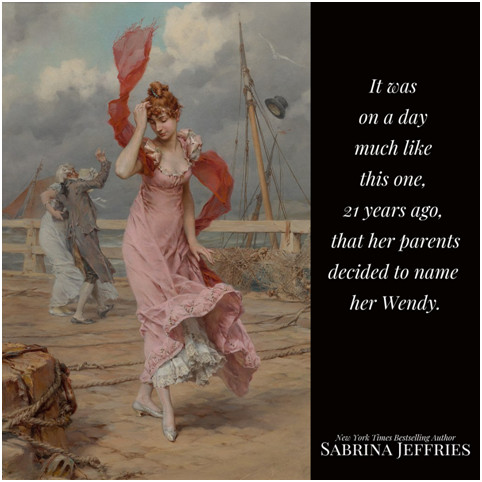
One question I get asked a lot is where I get the names for my characters. Mostly, I get them from a book: The Oxford Dictionary of English Christian Names (Christian names are first names, the name given at the baby’s baptism/christening). I consider myself fortunate to have been able to buy a copy years ago, since it’s now been long out of print. In addition to telling the origin and meaning of the name, it gives the periods when the name was popular and makes it clear when a name didn’t come into being until later.
But I also use the book to check a name’s suitability after I’ve picked a name for some other reason. For example, in Thorn and Ophelia’s story, I picked Mr. Juncker’s name from a Danish girlfriend I had in graduate school named Juncker. I wanted it to be German-sounding, and Juncker originated as a German surname. I also have a tendency to use Shakespearean names since I like Shakespeare’s works. Sometimes, a name just leaps into my head, and I use that one. But before I make it permanent, I always check for it in—you guessed it—The Oxford Dictionary of English Christian Names!
The Truth about Marriage
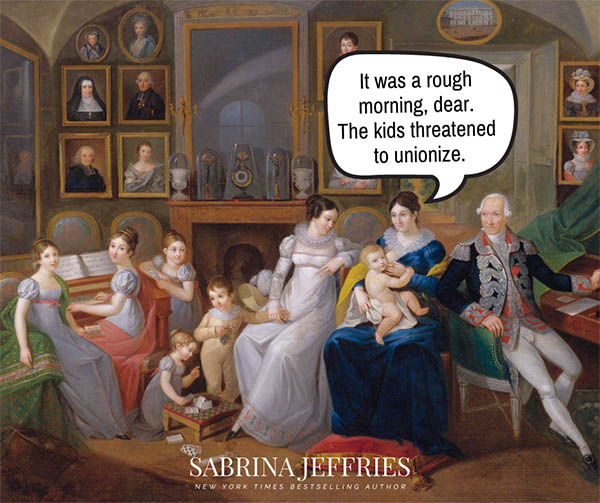
My favorite part about doing research is stumbling over real stories of people. We tend to have misconceptions about the past: Everyone married only once and died young is a popular one. The last part in particular isn’t true, because the data used to determine life expectancy factors in all the many children who died of illnesses that we now vaccinate for—polio, smallpox, measles, mumps, rubella, etc. Here’s a case in point. The Duke of Leinster and his wife, one of the famous Lennox sisters, Emily, had 19 children. Of them, only 10 survived to adulthood. One died on the day of her birth although I couldn’t discover if she was stillborn. The last child was actually Emily’s illegitimate son by William Ogilvie, the tutor to her eldest son, although her duke husband claimed him. After her husband’s death, she married Ogilvie and had 3 more children, only two of whom survived to adulthood. She lived to the ripe old age of 82 and he died at 91. He was 18 years younger than she, but they lived happily together for 40 years. She must have been one amazing woman, and he must have been an amazing man. The woman bore 22 children in all. How incredible is that?
Illegitimacy
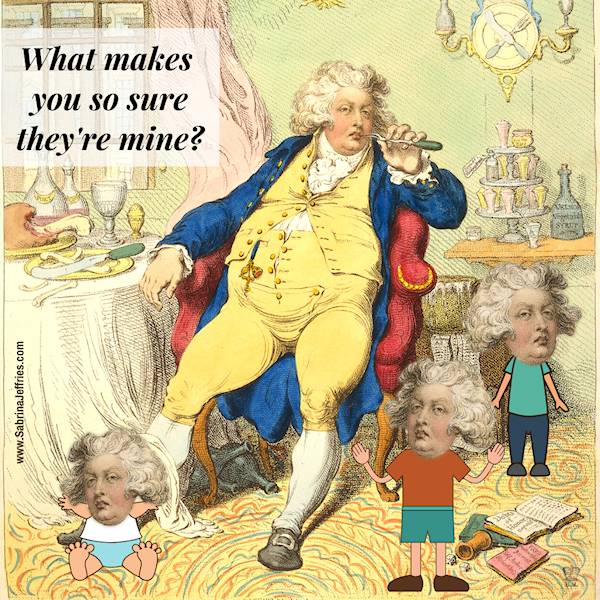
My Royal Brotherhood series is about three illegitimate sons of the Prince of Wales, whose term as Regent is what gave the period the name of “Regency.” Two of the three sons are actually considered legitimate by the laws of the time, so those two are able to have titles. English law dictated that if a child was born into a marriage, the father was legally the husband, no matter what he might say about it. And of course there was no way to tell in that period that the child was of a different father. Also, having a child by the Prince of Wales wasn’t exactly frowned upon, especially if the husband looked the other way. In fact, I loosely based Marcus, Viscount Draker and the hero of the second book, on George Lamb—fourth son of the first Viscount Melbourne—who was widely rumored to be Prinny’s son. It didn’t seem to have hurt him—George married a duke’s daughter!
Marriage
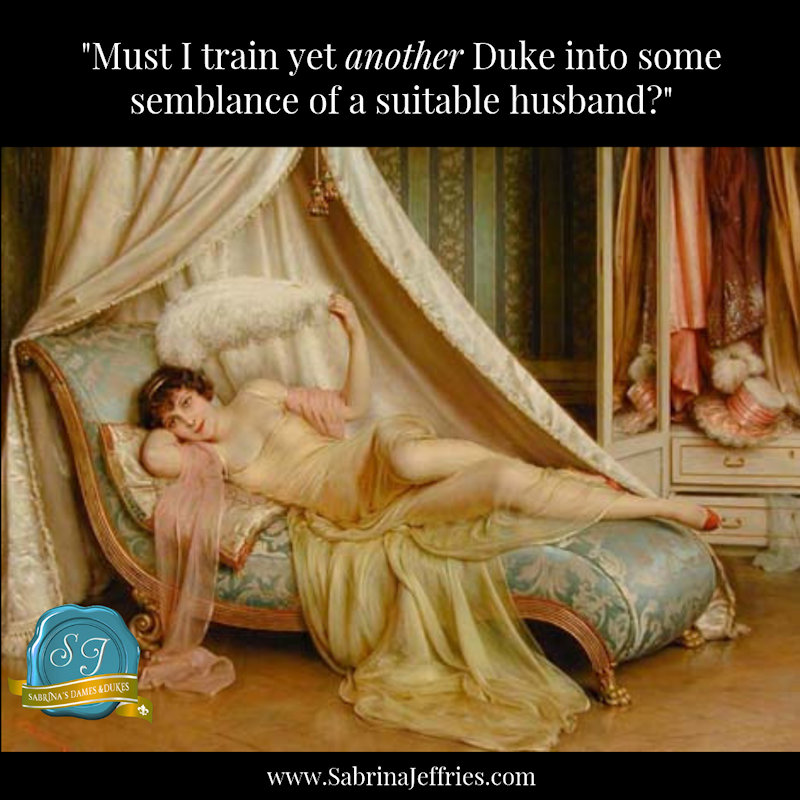
The concept of my series may seem farfetched: a woman marrying (and burying) three dukes in rapid succession (really, two dukes and a duke’s second son who becomes the duke) and having an assortment of children by them. But real-life debutante Elizabeth Gunning proved that it really was possible to marry well more than once. After taking society by storm as an actress, Elizabeth wowed London’s gentlemen with her beauty and talent. As a result, she ended up married to the Duke of Hamilton and bore him three children. After he died, she was briefly engaged to the Duke of Bridgwater before the engagement fell through. Then she married the Marquess of Lorne, who later inherited his father’s title of Duke of Argyll, and bore him five children. Eventually George III made her Baroness Hamilton of Hameldon in her own right. That’s quite a string of marital (and otherwise) successes for an actress!
Conservatories
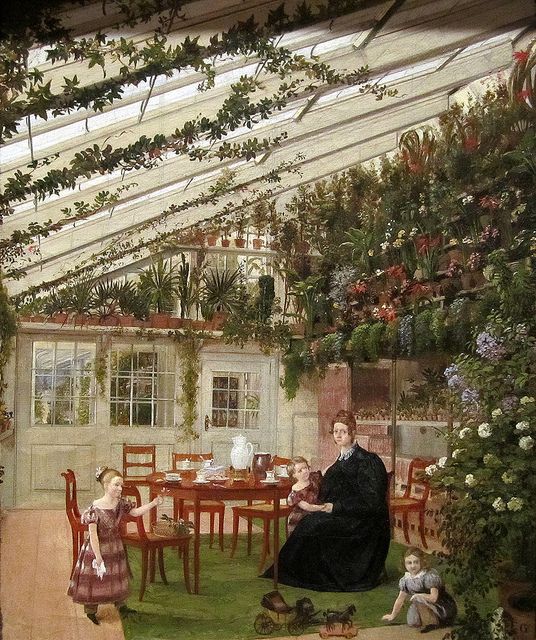
Many country houses had conservatories, but they could be as different as the families who lived there. The one pictured has lots of plants and plenty of space for socializing. Some had only a few plants; some were like inside forests. It was a way of nurturing exotic plants year-round, since essentially conservatories were greenhouses attached (sometimes) to the main houses. We’d probably call them sunrooms now. If you’d like to see a large detached one, check out the pics on my Pinterest page for the one at Syon House. I’ve been there! It was built right around the period of my book.
Home Renovation
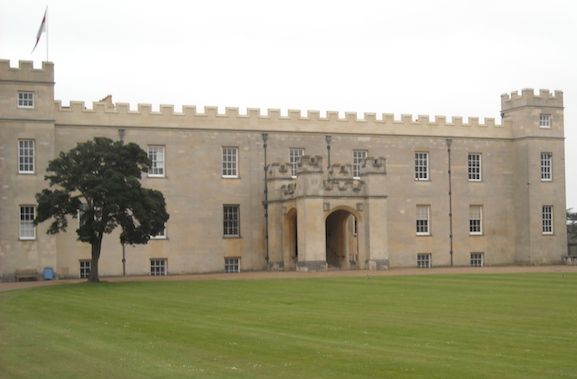
Even before the Regency, house renovation was becoming quite the thing. Horace Walpole took a nondescript cottage and redid it from the ground up to make it into the Gothic Revival villa Strawberry Hill. Some time after him, the first Duke of Northumberland renovated Syon House, but couldn’t finish because he ran out of money. You’d never be able to tell to look at it (yes, I’ve visited it; it’s lovely).
Letter Writing in the Regency

Letter-writing was a favorite Regency pastime — albeit a pricey one. The recipient bore the cost of delivery, which was calculated by the distance the courier had to travel. Long-winded epistles faced surcharges: the cost doubled for a second sheet of paper. People became quite crafty in using every bit of space a sheet of paper afforded. Some ladies were known to write horizontally, vertically and diagonally across the page. Envelopes didn’t exist, so letters were folded and sealed with a dab of melted wax.
Clothing
Men’s Attire
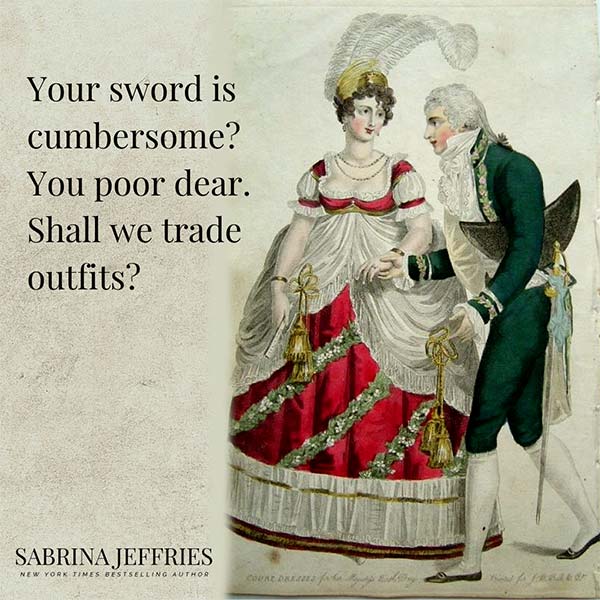
I believe I’ve written about how ladies dressed for their debuts (with pictures), but I don’t think I’ve talked much about how the guys who went to these things (and there were some accompanying the ladies) had to dress. Although I did describe it in The Bachelor, I go into more detail in A Duke for Diana. It’s fascinating, really, since they were all expected to dress in 18th-century attire, down to their powdered wigs and outdated coats! It would be sort of like having to wear jackets with big shoulder pads and Flock of Seagulls hair to a dressy event today. Oddly enough, they also had to carry ceremonial swords. Imagine dealing with those when normally if you carried something for protection, it was a pocket pistol. Below is a print that shows exactly how both sexes were expected to dress.
Fashion Dolls
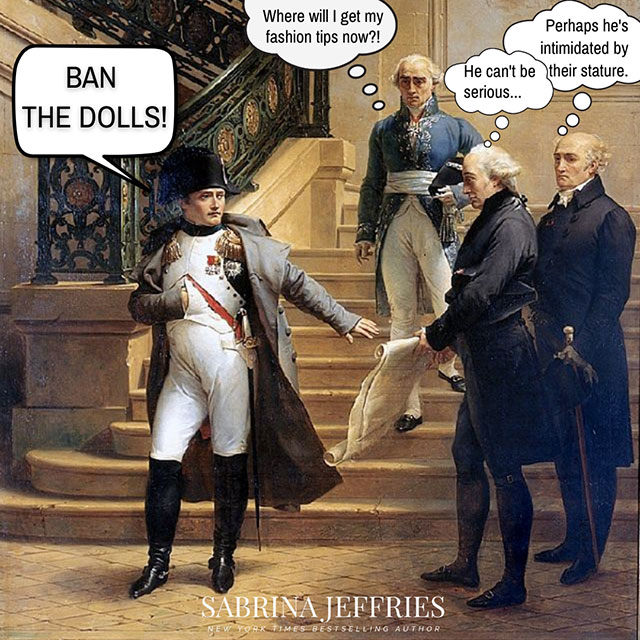
Did you know how fashion dolls began? They go back to the 14th century, but were mainly popular in the 18th and early 19th centuries as a way for dressmakers and tailors to demonstrate their fashions to their customers. Dolls could be used to demonstrate a new fashion in various fabrics or to show how variations on a particular fashion could work. They could also show what the latest fashions were in France . . . at least until Napoleon banned them during the Napoleonic Wars. He was afraid they’d be used to send secret messages to his enemies in England! They were still used a while longer in England, but eventually fell out of favor when fashion magazines became popular. But if you want to see an antique one, just check out this doll with a whole trousseau from 1810.
Beading
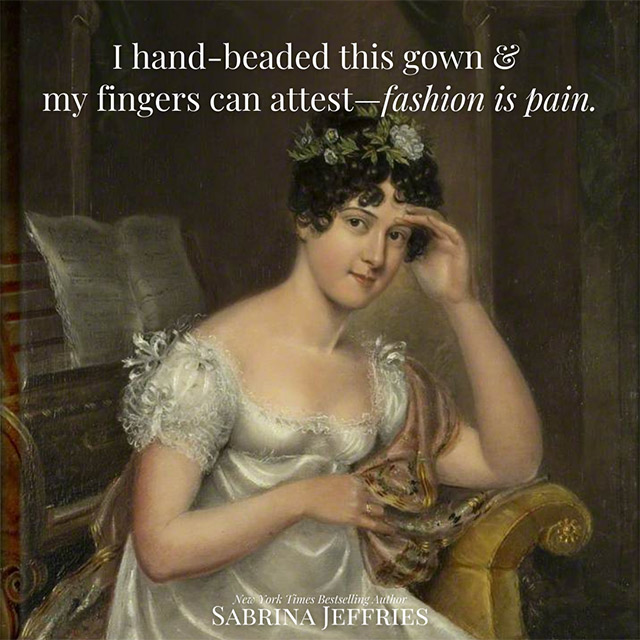
Regency era women of the ton wore beads (glass, not plastic) all the time . . . but on their dresses and reticules and even shoes! There’s a lovely example of a Regency beaded gown here. Just imagine how much time it took to sew all those colored beads on, not to mention drawing out the design in the first place. Years ago, I made my own wedding dress and sewed tiny pearls on just portions of it, and it took hours of work for my simple decoration. This is far more complex. So I would imagine only the rich could afford such a gown.
Court Fashion
Those of you who’ve read The Bachelor might have noticed that I talked about the odd attire required for those ladies presented at court and their escorts. Well, I didn’t make that up. Queen Charlotte did insist on powdered wigs for gentlemen and hoop skirts, ostrich feathers, and lots of jewelry for ladies. You can see several examples of those odd fashions here.
Young ladies had to wear white, but married ladies (like Beatrice) could wear colored gowns. Add a train to the gown, and you can only imagine how hard it was to walk in those fashions! Fortunately, ladies only had to wear them for their presentation at court. Then they could change into something more flattering.
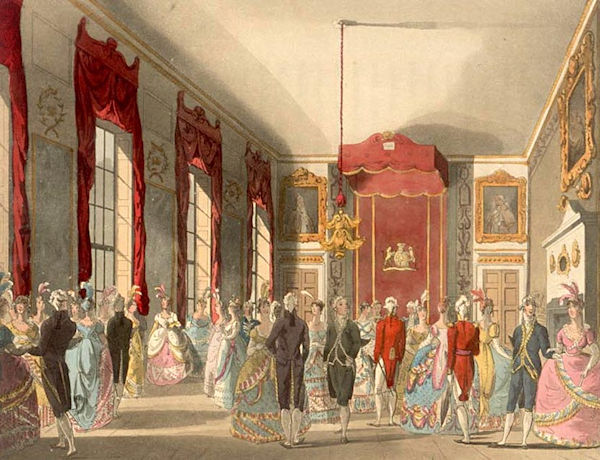
Children’s Clothing

Boys in the Regency did not dress the way we dress children now. They wore little “frocks” like girls until they were of a certain age (I’ve seen anywhere from 3 to 6 designated). Then they were “breeched” or put into breeches for the first time. In the Regency, this meant they were buttoned into a skeleton suit. And no, it’s not the Halloween costume—these were more like our modern day rompers, but with a coat-like top and trouser-like bottoms that buttoned together.
Hats
My heroine in The Risk of Rogues really loves big, elaborate hats. But I’ll tell you a little secret. She wasn’t that out of the norm for the times. In the 1830’s, the hats were outrageous! Some of these concoctions were three times the size of the wearers’ heads. Just go look at my Pinterest page for the novella if you don’t believe me. They’re replete with towering feathers, blossoming turbans that stick out like giant mushrooms atop their heads, and strange mixes of large hat brims atop tiaras with feathers sticking out all over. I think it just depended on who you were and how far you wanted to go. Honestly, Lady Anne would probably have been right in sync with some of society’s fashionistas!
Plumes & Feathers
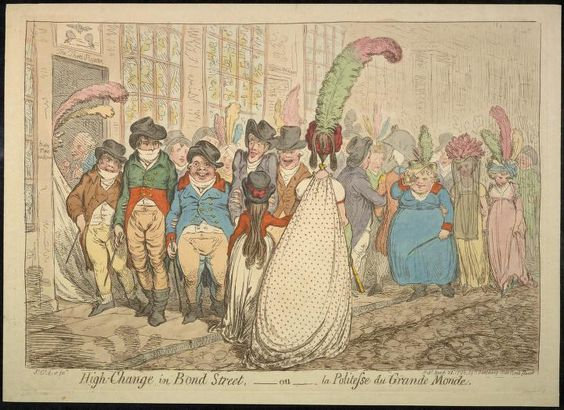
A prominent part of Hart’s story next July is his heroine’s love of hats and the feathers that adorn them. Lady Anne, who had a bit part in The Study of Seduction and wore outrageous hats, is his heroine, and he even gives her a peacock feather. Feathers were an important part of fashion in that period. Any young lady presented at court for her society debut was required to wear one or more towering plumes. Because of the expense, wearing a large ostrich plume showed that you were wealthy. But feathers could be found anywhere and incorporated into the design of hats, capes, reticules, etc. There were even professional feather-sellers called plumassiers, who ply their trade even today. So if you’re a lover of feathers, like me, you would be right at home in the Regency.
Health
Dieting
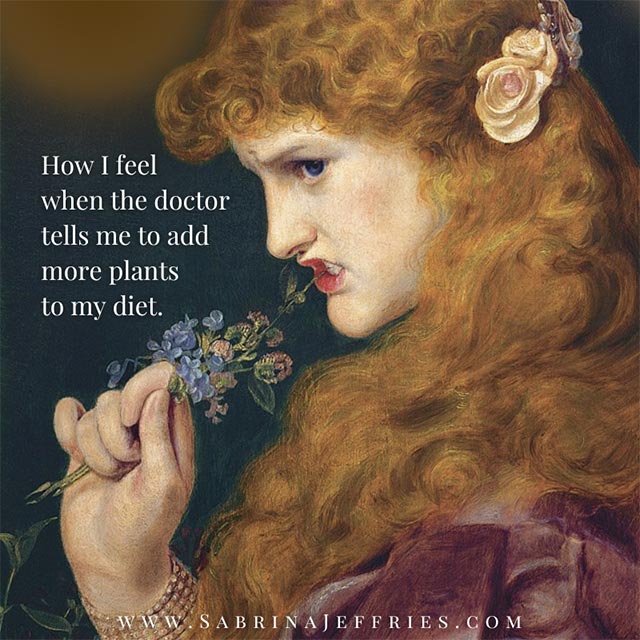
Dieting is not an invention of the modern age. For as long as there has been food, there have been diet programs and aids, not to mention doctors who instructed their patients to lose weight. The aid that still horrifies me was popular in the Victorian period—swallowing tapeworms. That’s one way to lose weight, but not a particularly healthy one. Here’s a lovely diet program from a man named Banting in the mid-nineteenth century. The diet was essentially low carb, even if it did have lots of wine in it. The Ugly-Girl Papers suggested a diet of fruit, with occasional broth, in order to achieve the translucent skin and sickly look that was apparently popular. Or . . . you could just eat arsenic wafers or drink ammonia. But before you scoff, my mom told us that when she and her sisters had colds as girls in the 1930s and ’40s, they were given a sugar cube soaked in kerosene to suck on!
Shaving
On Sabrina’s Dames and Dukes, I’ve been answering readers’ most pressing questions, and one that comes up time and again is about hygiene: How did women shave their legs and underarms? The answer is simple—they didn’t. Until the early twentieth century, having body hair was considered perfectly acceptable in Western cultures. Then sleeveless dresses with higher hemlines came along, and the fashion industry used that to preach that hairless equaled more beautiful . . . mostly so they could sell razors. We’re so used to shaving body hair now that we can’t imagine a woman having her underarm and leg hair intact, but in the Regency, no one thought twice about it! If you want to chat about fun Regency tidbits, join us on Sabrina’s Dames and Dukes.
Home Medicine
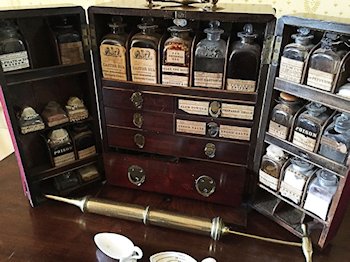
An apothecary box features prominently in A Talent for Temptation. Think of it as the Regency version of a home medicine chest. In addition to some of the things you might find there—like pain relievers, antacids, and tongue depressors—you’d find scales for measuring out powders, jars of potions that often included opium or alcohol (or even lead or mercury), and a lot of odd medical implements . . . whatever a doctor or housewife might have needed then. We saw one firsthand when we visited The Georgian House in Edinburgh, but my picture was so blurry, I’m not going to use it. Instead, here’s a link to an article with a great picture that details some “medicines” in the box, which also included an enema syringe (ugh) and a mortar and pestle.
Marriage
The Truth about Marriage

My favorite part about doing research is stumbling over real stories of people. We tend to have misconceptions about the past: Everyone married only once and died young is a popular one. The last part in particular isn’t true, because the data used to determine life expectancy factors in all the many children who died of illnesses that we now vaccinate for—polio, smallpox, measles, mumps, rubella, etc. Here’s a case in point. The Duke of Leinster and his wife, one of the famous Lennox sisters, Emily, had 19 children. Of them, only 10 survived to adulthood. One died on the day of her birth although I couldn’t discover if she was stillborn. The last child was actually Emily’s illegitimate son by William Ogilvie, the tutor to her eldest son, although her duke husband claimed him. After her husband’s death, she married Ogilvie and had 3 more children, only two of whom survived to adulthood. She lived to the ripe old age of 82 and he died at 91. He was 18 years younger than she, but they lived happily together for 40 years. She must have been one amazing woman, and he must have been an amazing man. The woman bore 22 children in all. How incredible is that?
Illegitimacy

My Royal Brotherhood series is about three illegitimate sons of the Prince of Wales, whose term as Regent is what gave the period the name of “Regency.” Two of the three sons are actually considered legitimate by the laws of the time, so those two are able to have titles. English law dictated that if a child was born into a marriage, the father was legally the husband, no matter what he might say about it. And of course there was no way to tell in that period that the child was of a different father. Also, having a child by the Prince of Wales wasn’t exactly frowned upon, especially if the husband looked the other way. In fact, I loosely based Marcus, Viscount Draker and the hero of the second book, on George Lamb—fourth son of the first Viscount Melbourne—who was widely rumored to be Prinny’s son. It didn’t seem to have hurt him—George married a duke’s daughter!
Food
James Hemings
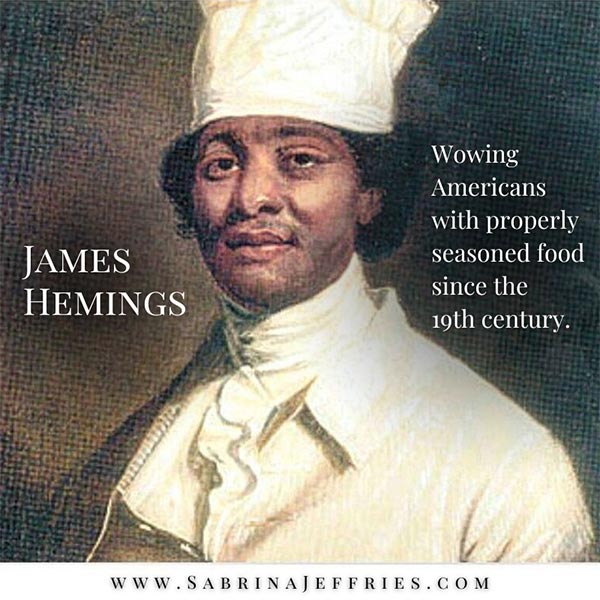
As y’all know, I occasionally base my characters—both main and secondary—on real historical figures I read about. One of those will make his first appearance in Eliza’s book. He’s a well-known French chef and a man of color who works for Elegant Occasions. I was inspired by a man I’d read about recently: James Hemings, the brother of Sally Hemings. He’s credited with introducing Americans to snow eggs and his version of mac and cheese, among other things. He learned about similar foods while training in France to be a chef, the first American to do so. He excelled to such a degree that he became chef de cuisine at the Hôtel de Langeac, Jefferson’s private residence, and the first American diplomatic embassy while he was in Paris. My character is French, not American, but he too has risen to prominence in England, as many French chefs did. He’ll also be in Verity’s book, which I’m presently plotting.
Prawlongs
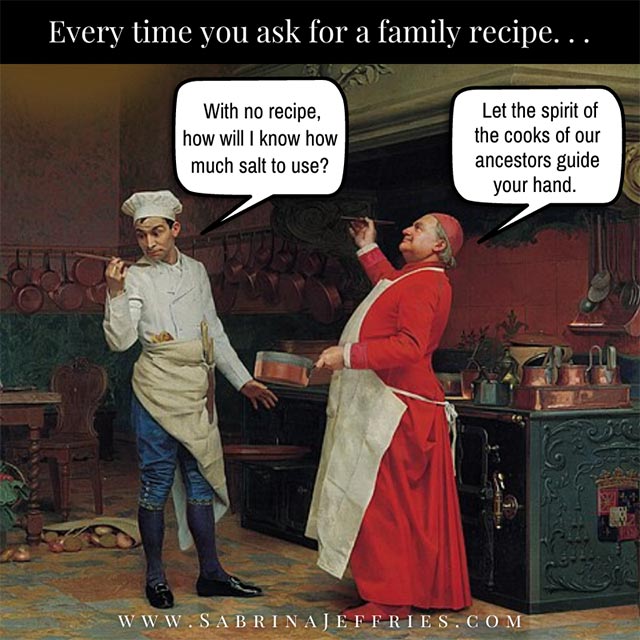
You’ll probably be wondering, when Eliza’s book comes out in late March and prawlongs are mentioned several times, what exactly are prawlongs? Basically, they’re nuts or orange flowers or lemon or orange rinds coated once or twice in caramelized sugar. Sounds yummy, right? I’m not sure why pralines came to be called prawlongs, but they did. Just see Frederick Nutt’s 1807 cookbook, The Complete Confectioner, which has several recipes (although they contain no ingredient amounts; I haven’t had much luck finding that anywhere). The prawlongs I find most interesting are the pistachio ones, since they came in two colors—red and white. Here’s the red recipe:
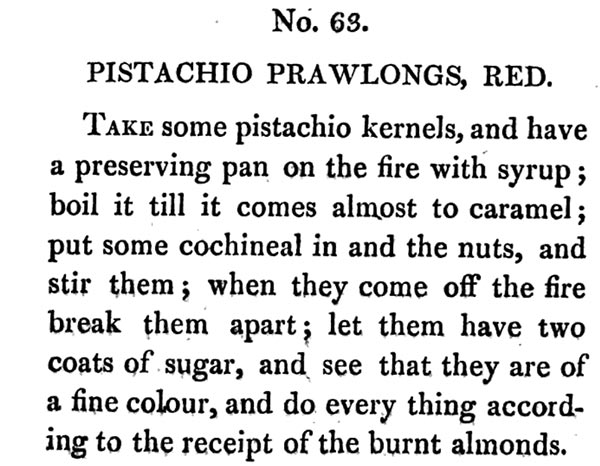
Foods of England
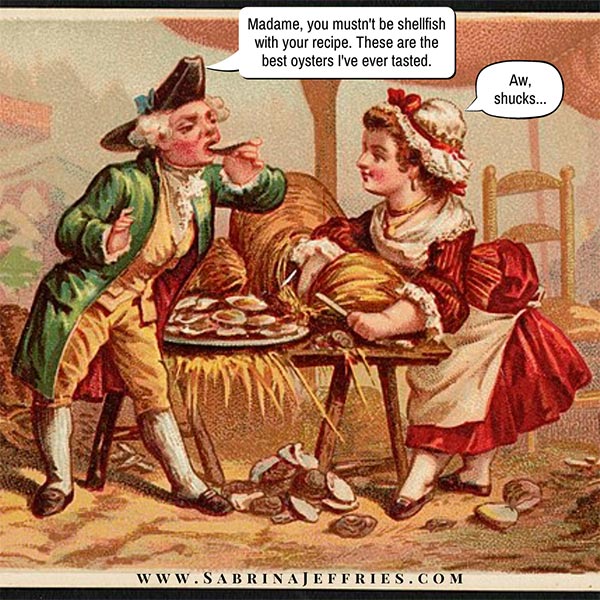
Accidentally His is my foodie book, if there ever was one. After all, food is Verity’s life. In the process of researching, I’ve discovered this wonderful site called The Foods of England Project, which contains 60 out-of-print historical cookbooks, and thousands of recipes and dishes, with their histories. One of the dishes I used for the book is Mussel and Onion Stew, which is Rafe’s favorite. It comes from the West Country, which is where Rafe grew up and Verity’s father still lives. I’m not fond of mussels myself (which is odd, because I like just about every other shellfish), but I stumbled across the recipe and thought it might be fun to include. And there’s Duke’s Custard at the end of the book! (Literally—it shows up in the epilogue, but I call it trifle because that’s really what it is.) Now, that’s one I’d love to try.
Chocolate
While chocolate as we know it didn’t really exist in the Regency, there was a confectioner named Guglielmo Jarrin who created eggs out of rock sugar. He also had a recipe for created transparent hollow eggs of sugar that could then be filled with yellow cream so they resembled real eggs ala Cadbury Crème Eggs. I wish I could have seen these. They sound so cool! But there’s no way I could make them, even if I could find the lead moulds for them. If you want to try, however, you can check out The Italian Confectioner, available in its entirety online at Google Books.
Fried Potatoes (French Fashion)
Potatoes have long been a staple of both English and Irish cooking. Still, I was surprised to find a Victorian-era recipe for “Fried Potatoes (French fashion)” which is what I would consider potato chips. Check out Mrs. Beeton’s Book of Household Management (online at http://www.mrsbeeton.com). She talks about thin slices of potato fried in oil—if that’s not potato chips (or crisps, in British English), I don’t know what is. Mrs. Beeton was a Victorian lady who gathered household tips and recipes into the aforementioned book, which was published by her husband. I’d like to try the “Potato Snow” recipe. It sounds interesting (and far better than the real snow everyone has been experiencing).
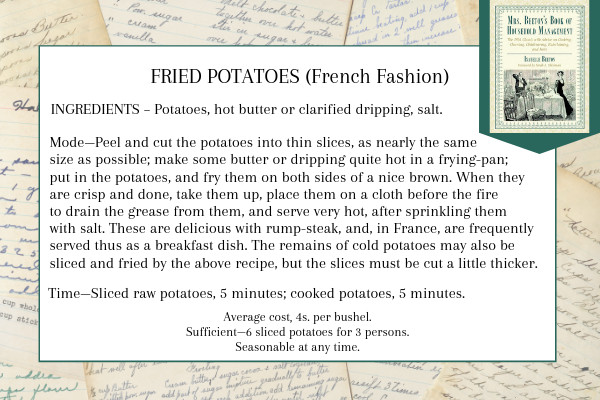
Historic Foods – Pie
Thanksgiving is coming and to me that always means good food! Specifically pie. I love pie, both the savory kind and the sweet kind, but I rarely eat it because of all the carbs. Except on Thanksgiving and Christmas, that is. My English/Irish blood (as opposed to my Cajun blood) must be showing because the English/Irish like pie, too. They eat more savory ones than we do, but you can still find sweet pie recipes in the Regency. At Christmas, it would have been mincemeat pie primarily. It’s not the favorite of Cass from Seduction on a Snowy Night, if you’ll recall, but I like it. I remember my half-Irish grandmother in St. Louis making it every year. Here’s a nice history of mincemeat pie and a period recipe. And if you’re interested in other historic foods (although mostly from the early Georgian and the Victorian periods), you can’t go wrong with Historic Food.
Ice Houses
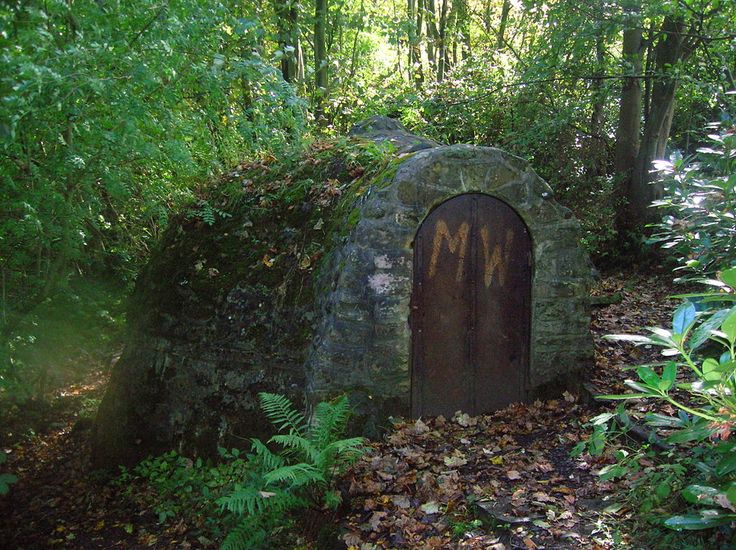
Most people assume that ice didn’t exist in summers during the Regency, but the wealthy did have access to it. Ice houses were big, deep wells where ice harvested from nearby frozen lakes (or sometimes ordered and brought in from the Arctic) was kept through the year. A well-built ice house could keep ice for as long as 18 months, which is pretty amazing. That’s how the famous Gunther’s in London managed to provide ice cream throughout the summers.
Ices and Ice Creams
There’s a scene in The Bachelor where Joshua, Gwyn, and Gwyn’s mother Lydia eat ice cream at Gunter’s. The wealthy did actually eat ice cream in summer during our period, using ice either shipped in from Norway or cut and placed in their own ice houses. Gunter’s was only the most famous purveyor of ices and ice creams. But the flavors were unusual by our standards. Muscadine ice was a lemon water or white currant ice scented with elderflowers. Flowers were popular flavors—lavender, bergamot, jasmine, and orange flower, for example—but there were also burnt filbert, rye bread, parmesan cheese, and tea flavors! One of these days I’m going to try my hand at some Regency ice cream. But I’ll skip the rye bread flavor!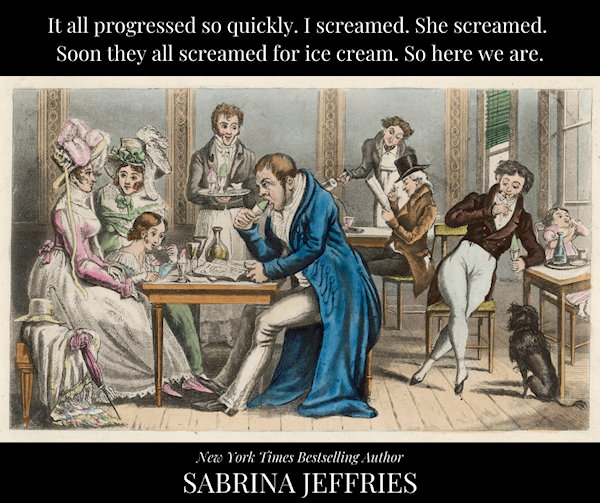
Seafood
The English in our period were quite fond of seafood. My period cookbooks have recipes for such things as smoked fish soup, mackerel pie, fried anchovies, collared eel, and even boiled crayfish (yes, they have crayfish in England). You don’t find recipes for periwinkles and whelks because they were common food for the common people. But they’re mentioned in the famous cookbook by Mrs. Beeton (1861), where she has a table of how much seafood of every type was sold that year in London. Apparently, Londoners ate 4 million whelks (compared to half a million crabs and a million lobsters) and an astonishing 304 million periwinkles!
Turtle Soup
Turtle soup was common on menus in England going back to before the Regency. It had to always be included as a dish for the Lord Mayor’s Banquet in London, and was so popular (and so expensive) that the English even developed Mock Turtle Soup for those who couldn’t afford turtle meat. Mock turtle soup was traditionally made with a calf’s head, so if the idea of eating turtle makes you gag, you might like the mock version even less. Personally, having eaten plenty of it in New Orleans, I enjoy the real thing.
Holidays
Valentine’s Day Lottery
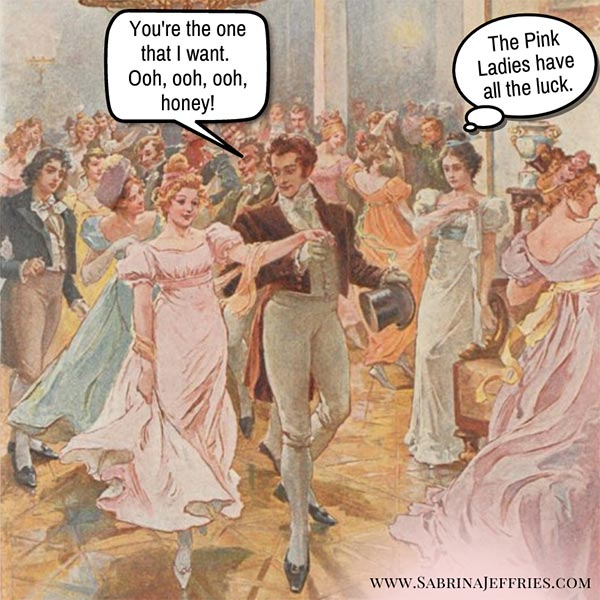
In researching my scene for The Truth About Lord Stoneville, I found the most interesting Regency-era Valentine’s Day tradition: a lottery (I used it in the book, too). On Valentine’s Day evening, young people would draw names out of a hat to discover who would be their valentine for the coming year. It was supposed to be a predictor of matrimony. I did have some trouble understanding the logistics, since everyone drew a name. What if Mary drew George’s name, while George drew Joan’s? I wasn’t quite sure how that worked, so I . . . er . . . altered it a little. Call it poetic license, if you will. I still think it sounds like fun . . . unless, of course, you don’t draw the person’s name you want for a valentine.
May Day: Jack-in-the-Green
You may have scratched your head at the part of Eliza’s book about the Jack in the Green. It’s not as commonly known a May Day custom as the maypole, for example, but it does play a part in the festivities. Primarily for chimney sweeps, it was part of the usual May Day processions: The sweeps dressed up like bushes or trees (!!) and danced (or staggered, depending on their degree of drunkenness) down the street. Apparently, May Day was sometimes called Chimney Sweepers’ Day. I have no idea why. But here’s a fun picture of a Jack-in-the-Green and his drunken companions (colorized by the print owner).
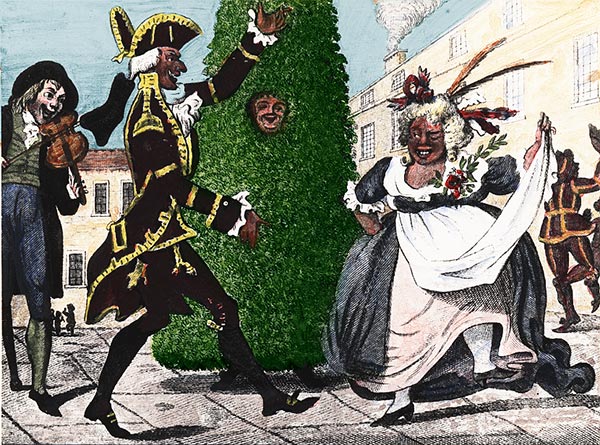
Jack in the Green certainly does seem appropriate for celebrations of the coming of spring. You can read more about the custom here.
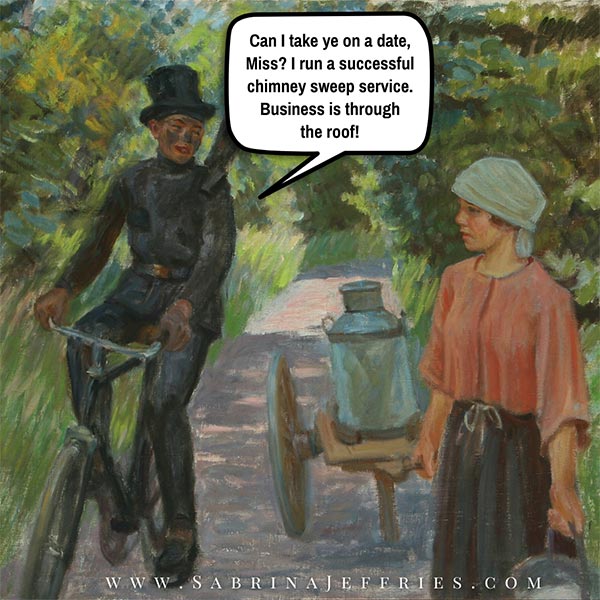
New Year’s Superstition
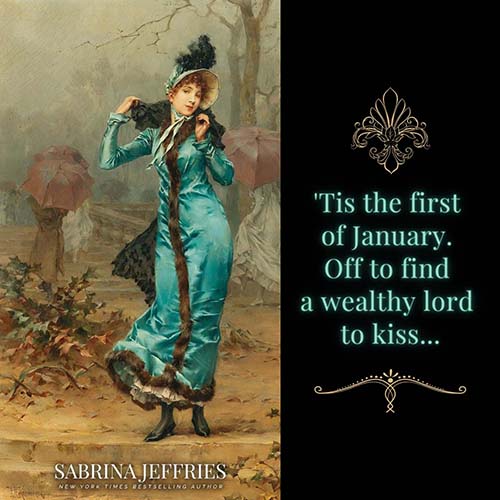
Why must I not bitch and moan about my back and neck pain? Because a big superstition connected to New Year’s Day in Regency England was that whatever you did on New Year’s Day, you were doomed to repeat for the entire year. Our Regency foremothers would particularly suggest that you avoid cleaning your house (you might sweep out your good luck, not to mention having to spend the coming year sweeping), getting into debt, leaving your cupboards bare (which might foretell poverty in the new year), and crying (which means you’ll be sad all year—duh!). Definitely do kiss your beloved (well, that one is probably more modern). And be sure to open your doors and windows just before midnight to let out the old year and beckon in the new one.
Holiday Music
It’s a bit early to talk about the holidays, but since my Christmas story is coming out any day now (and decorations are already showing up in places), I figure y’all will forgive me. Most people are unaware that many of our most popular Christmas carols don’t date back very far. “Silent Night” was first composed in 1818 and didn’t make it to other countries until decades later. “Angels We Have Heard on High,” “It Came Upon a Midnight Clear,” and “Away in a Manger” are mid-Victorian. All of our secular carols are from the 20th century and on. So instead of putting a carol in my Christmas story, I put phrases from an assortment of carols from all periods into the mouths of my unwitting characters. There are nine of them. Have fun finding them!
New Year’s Traditions
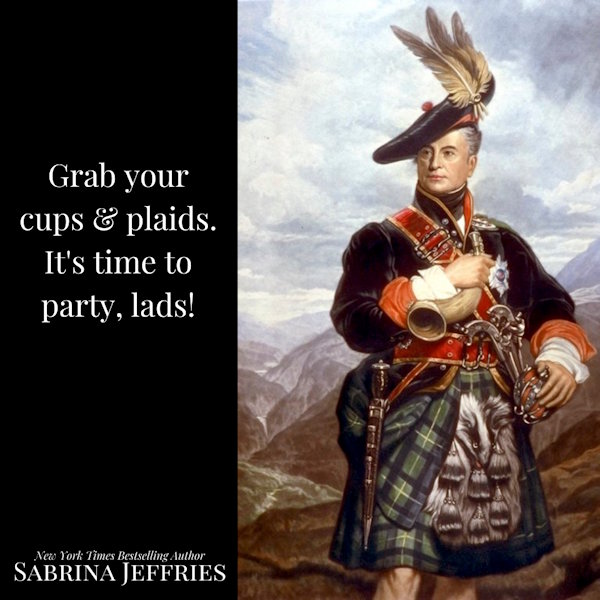
Although the U.S. has several New Year’s Day traditions, especially involving certain meals eaten for good luck, there was no such equivalent in most of Regency England. For that, we have to go farther north. While most of the English were engrossed in the countdown to Twelfth Night (on January 6th), those who lived up north joined the Scots in having big parties on Hogmanay. Hogmanay is New Year’s Eve and also spills over into New Year’s Day in its traditions. You may have heard of first-footers, who vied to be the first person to cross the threshold of a friend’s house in the New Year, and thus were bringers of good luck for the year. Gifts were carried in and distributed—salt, coal, shortbread, whisky, black bun (food and drink for the guests), and other items that might bring luck. But you probably don’t know about local customs—people bringing a decorated herring into the house (Dundee) or roaming the streets swinging fireballs (Stonehaven, Aberdeenshire) or baking special cakes (St. Andrews). I could go on, but suffice it to say, the Scots really knew how to celebrate the new year!
New Year’s Day
According to William Hone’s period tome, The Every Day Book, New Year’s Day in London was primarily celebrated with small social gatherings and the wearing of new clothes (out of a superstition that not doing so was unlucky—which Mr. Hone disparages). He also says, “The only open demonstration of joy in the metropolis, is the ringing of merry peals from the belfries of the numerous steeples, late on the eve of the new year, and until after the chimes of the clock have sounded its last hour.” I think I’d prefer that to fireworks.
Valentine’s Day
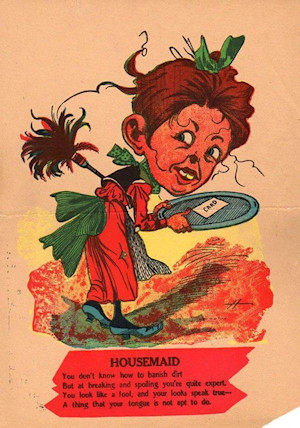
The Risk of Rogues takes place partly on St. Valentine’s Day, which was celebrated even then. Before Christmas cards became a thing in the Regency, St. Valentine’s Day cards were exchanged with loved ones. These were usually handmade and decorated, although in 1815, companies started mass-producing Valentines. In the Victorian age, a class of cards called “mocking Valentines” (“vinegar valentines” in the U.S.) started to be produced. Essentially, they insulted the person who received them. Can you imagine getting one of those in the mail? Especially since, at this time, it was the receiving party who paid the postage. Talk about adding insult to injury! Anyway, you can see a variety of Valentines from the period on my Pinterest page.
Greeting Cards
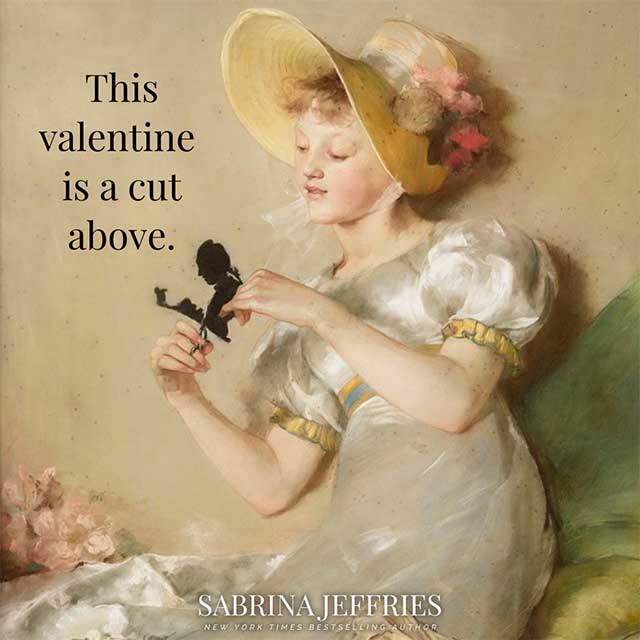
Did you know that the first British pre-printed greeting cards were valentines and not Christmas cards? Before the late Georgian era, people were sending elaborate hand-made valentines, with actual fabric lace and ribbons and other pretty trimmings. In 1797, a book was even released to provide unpoetical gentlemen with valentine sentiments: The Young Man’s Valentine Writer. In fact, handmade valentines out-sold pre-printed ones until the Victorian age began. It’s no wonder, when artists like Elizabeth Knipe Cobbold were creating intricate cut paper valentines with their own hand-written poetry, like this one on my Pinterest Guide to Regency valentines.
Regency Valentines
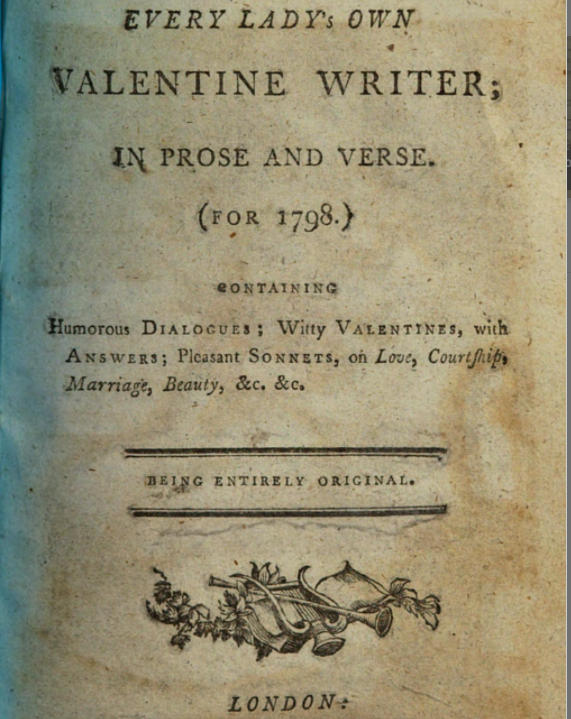
Regency Valentines were much the same as ours, except that they were home-made, because commercially produced cards weren’t yet available. Well, that’s sort of true. The decorations could be your own, but as usual, not everyone could come up with a good verse for their Valentine. So you could get books to tell you what to write. My favorite is Hymen’s Rhapsodies, or Lover’s Themes. A collection of original Valentine Verses Written expressly for this Work, for Gentlemen to Address Ladies in Sonnets, Superior to Any Other. Phew! That’s a long title. But at least you knew what you were getting when you bought it. There was even a book that gave you verses for various trades! And the author of the book, the title page of which is pictured below? It’s “Love.” Yes, Love itself wrote the book. Anyway, if you’d like to see some Regency-era valentines, you can visit my Pinterest page for them. You might also be interested in my guide to making your own Regency valentines. Have fun! For more Regency tidbits, click here.
A Valentine’s Day Limerick
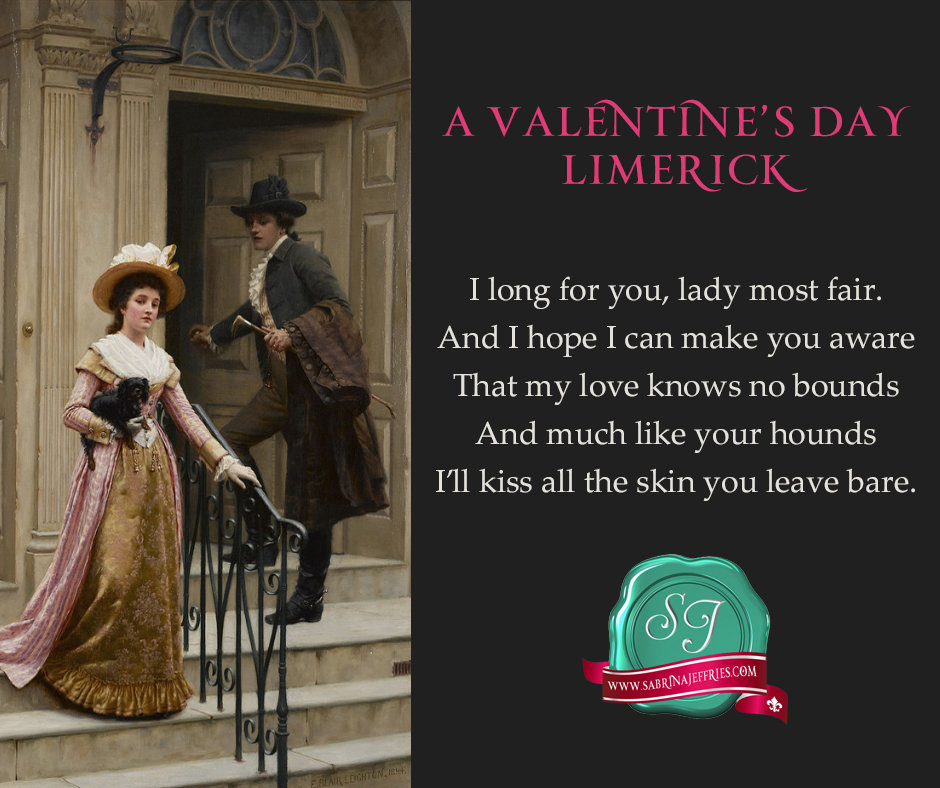
You may not be aware, but it was considered unseemly for a Regency gentleman to write letters to a young lady or vice-versa. Communication was supposed to go through the parents. That didn’t stop ladies from checking the mail while Papa was preoccupied, of course, so papas were particularly careful on Valentine’s Day, which was when gentlemen (and rogues) sent valentines. Thus it was with some enjoyment that I read an old blog by Two Nerdy History Girls (authors Loretta Chase and Susan Holloway Scott) about a father who intercepted a couple of “obscene” Valentines before they could horrify his daughters. I found the original letter to the editor concerning this event and was greatly amused. Today the equivalent would be dirty pics in Messenger. In my day it was obscene phone calls. Apparently, in the regency, “depraved” valentines contained what were probably the equivalent of bawdy limericks. But I still wish I knew exactly what was in those valentines, don’t you?
April Fool’s Day
April Fool’s Day (aka All Fools’ Day) goes back at least to the 17th century in England. In 1698, someone invited lots of people to go see a fictitious “washing of the white lions” at the Tower of London (where they used to keep the menagerie). It worked so well that some bright fellow in 1860 decided that the prank deserved a repeat and actually sent out invitations to the “washing of the white lions.” Several people showed up, only to find that there were no longer any lions at the Tower, much less any that needed washing.
Easter
Easter was a time for visiting family. Remember the long visit Darcy and his cousin Colonel Fitzwilliam make to Lady Catherine? It happens at Easter. While Easter celebrations didn’t yet include bunnies and chocolates, dyed hard-boiled eggs were part of them. Since eggs were generally given up for Lent, the excess hen eggs were saved by being boiled. They were even part of a traditional English Easter past-time called “egg rolling,” where people rolled their dyed, boiled eggs down hills to see who could roll theirs the farthest.
May Day

May Day has been celebrated throughout the United Kingdom for centuries, although the festivities had started dying out a bit during the Regency. Still, Jane Austen mentions the neighborhood maypole blowing down in a storm, and the Hampshire Chronicle speaks at length about the celebrations in 1815, which involved couples dancing in or on a flower-laden bower (I couldn’t picture this from the description). See this blog for more about these citations. Other parts of May Day included crowning a May Queen, and the more obscure practice of leaving small May baskets of treats for people.
Oktoberfest
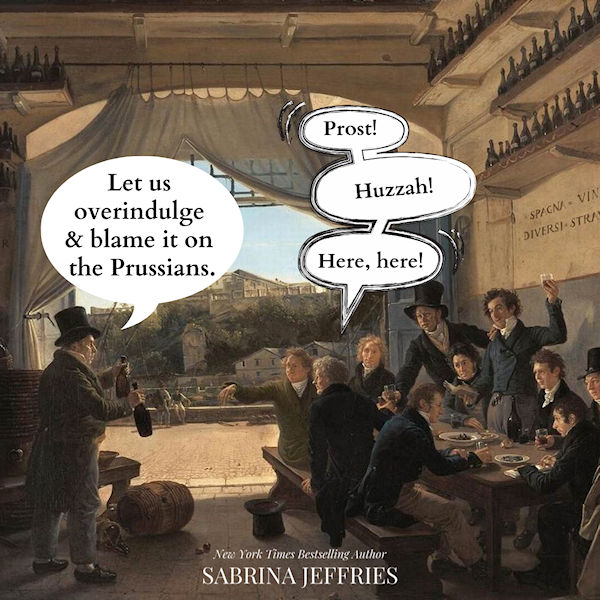
Recently, I was surprised to discover that Oktoberfest goes back to before the Regency. I had no idea. In fact, the first celebration was in Munich, Bavaria (now considered part of Germany) in 1810 (when Thorn’s book is set and a year before the official Regency period begins). It began as a celebration of the marriage of the Crown Prince Ludwig to Princess Therese of Saxe-Hildburghausen. The wine and beer flowed, and there were performances by choirs and children in costume. But the main event was a grand race of thirty horses. Those elements have been part of it ever since, along with other typical festival events, and it’s been canceled only twenty-four times out of the 209 years it’s been held (for example, it was cancelled in 1813 because of the Napoleonic wars, and in 1854 due to a cholera epidemic). So you would be perfectly at home if you celebrated Oktoberfest in your Regency costume!
Halloween
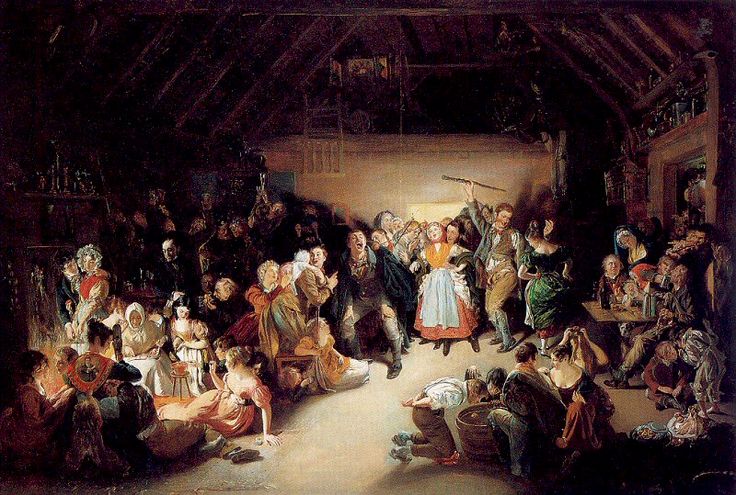
The Regency contained little in the way of Halloween (All Hallow’s Eve) celebrations. Although the holiday is essentially descended from Celtic celebrations of Samhain, the period marking the end of summer and beginning of harvest, it didn’t have much place in Regency England. But the bonfires associated with Samhain became part of the Guy Fawke’s Day revelry, which occurred on November 5th and was meant to celebrate the arrest of an insurgent in 1605 England. So there was still plenty of trickery going on around All Hallow’s Eve.
Guy Fawkes Day
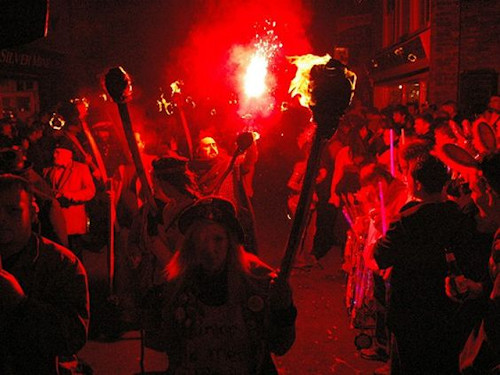
By now, you may have already read The Secret of Flirting, so you might be curious about my depiction of Guy Fawkes’ Day, especially if you’re English. Nowadays, it’s mostly an excuse to set off fireworks and light bonfires and to celebrate with family, but that wasn’t true in our period. This was right before the Reform Act of 1832, when a lot of class conflict existed. The Fifth of November, the anniversary of when the Gunpowder Plot was thwarted, became an excuse for rioting, day and night. Asking a penny for “the Guy” was also popular as boys went around with their effigies of Guy Fawkes and collected money for fireworks that night. I tried to incorporate as much of that in The Secret of Flirting as I could. You know me—I love a holiday!
I found some fascinating research on Guy Fawkes Day. Check out this article I pinned to The Secret of Flirting board on Pinterest to find out more about this drunken and sometimes destructive “holiday.”
Christmas Traditions
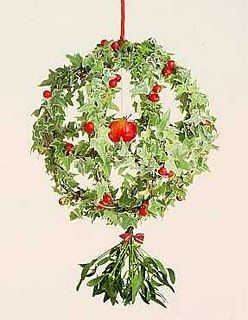
The hanging of greenery was the most common Christmas custom practiced by folks in the Regency. Dating back before our era was the custom of hanging a “kissing bough.” It could include not just mistletoe, but holly, ivy, rosemary, bay leaves, and laurel leaves. It was essentially a big ball of greens. And every time a gentleman kissed a lady (or a maid or a dowager or any female), he had to remove one of the mistletoe berries. Once the berries were gone, no more kissing was allowed. What great fun! If you’d like to see some actual kissing boughs, as well as prints of the kissing going on beneath them, be sure to check out my Pinterest page for What Happens Under the Mistletoe.
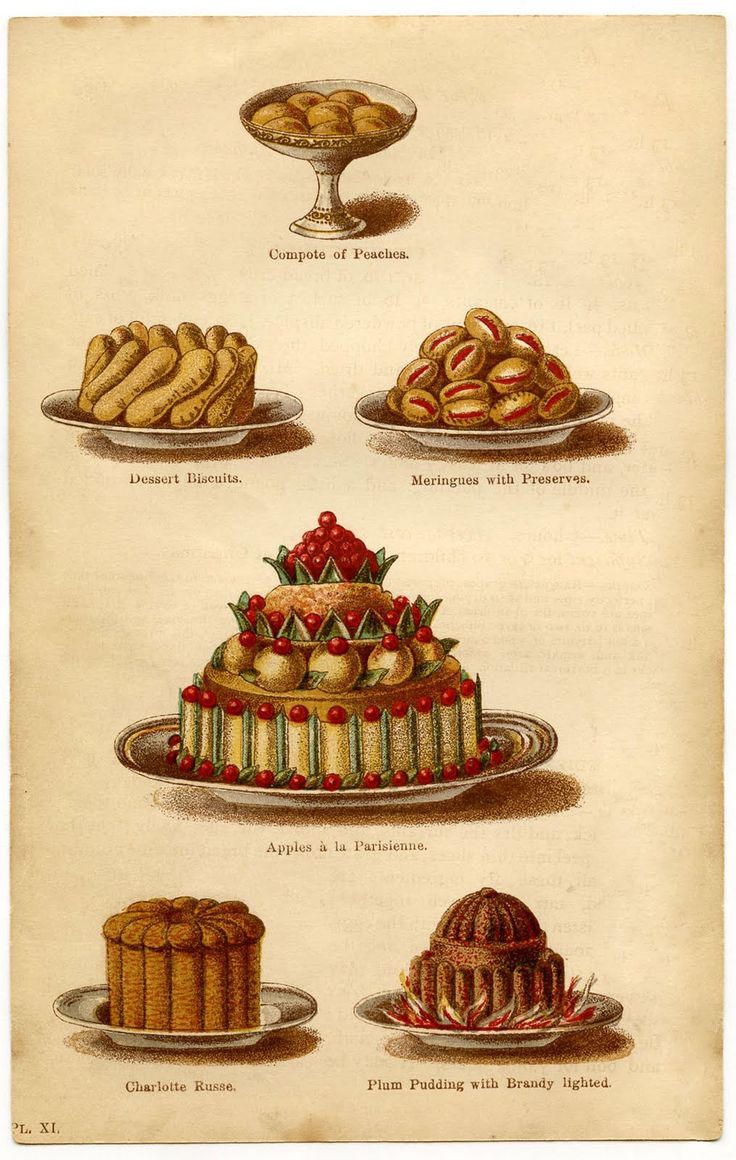
One thing that comes from England is fruit cake (our version of plum pudding), and there’s both goose and turkey in Scrooge’s story. Also, the Yule log and the hanging of holly, ivy, and mistletoe are English. You can thank those ancient Celtic druids for mistletoe—they loved it in their winter celebrations. No one is entirely sure whether the Yule Log originated in Anglo-Saxon times or much later, in the 17th century (the first English reference to it is dated from then), when someone brought the custom over from Europe. But it tended to be a regional phenomenon in our period. Those in North England called it the Yule Clog, and it was generally started from a piece of the previous year’s log that was kept all year to bring good luck and protection from evil to the household.
Christmas Meal
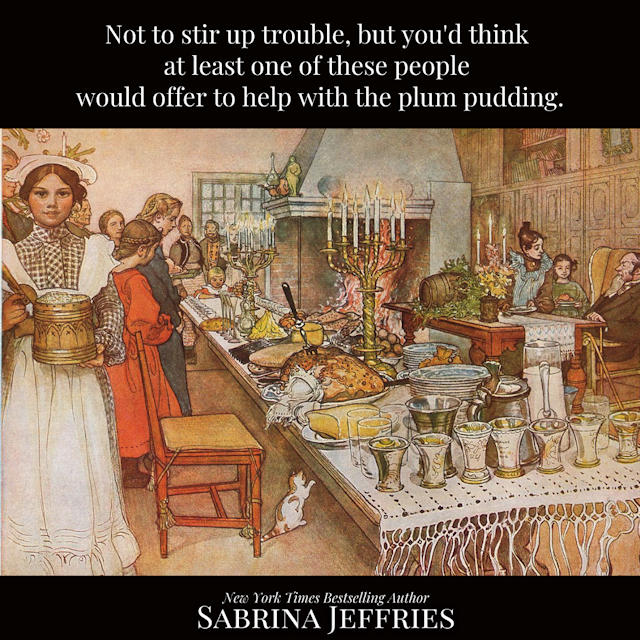
You may think I’m beginning a bit early to think about the Christmas meal, but I’m right on time according to British tradition. I’m writing this on the Thursday before Stir-up Sunday (this year on November 22nd), which is the day everyone in Regency England would have been “stirring up” their Christmas plum pudding. I’m sure plenty of you already know this, but British plum pudding is more like our U.S. fruitcake in its consistency and ingredients. What we call pudding is what the Brits would call custard or blancmange … but I digress. Stir-up Sunday always falls on the Sunday before Advent Sunday. There’s a complicated reason for why it’s called Stir-up Sunday, having to do with the Anglican liturgy, but the upshot of it is that plum pudding has to be prepared and cooked well in advance, and apparently it takes a lot of people to stir it up. (It sounds a bit like churning butter to me, and that’s hard.) After all, you need to have some strength left in your arm for hauling Yule logs and a Christmas tree!
Christmas
The Dickensian Christmas is pretty close to how a Regency Christmas was, since Dickens was born early in the Regency period. There are no trees or stockings in A Christmas Carol, just lots of food, dancing, Christmas carols, and party games as well as greenery. Much of what we think of as an English Christmas did not come into being until the Victorian age. Christmas trees come from Germany, and the Dutch brought Sinterklaus to America long before Santa ever showed up in London.
That’s true of stockings as well, which is why I showed them as an anomaly in ’Twas the Night After Christmas (set in 1826). After Lady Devonmont reads the American poem “A Visit from St. Nicholas” (aka “’Twas the Night Before Christmas”), she decides it would be great fun to make stockings. But the custom of hanging them was practiced in America long before it started being practiced in England, because it was brought there by Dutch and German immigrants. The first reference I can find to it in England is in 1854. Eventually it became a big part of a Victorian Christmas.
Twelve Days of Christmas
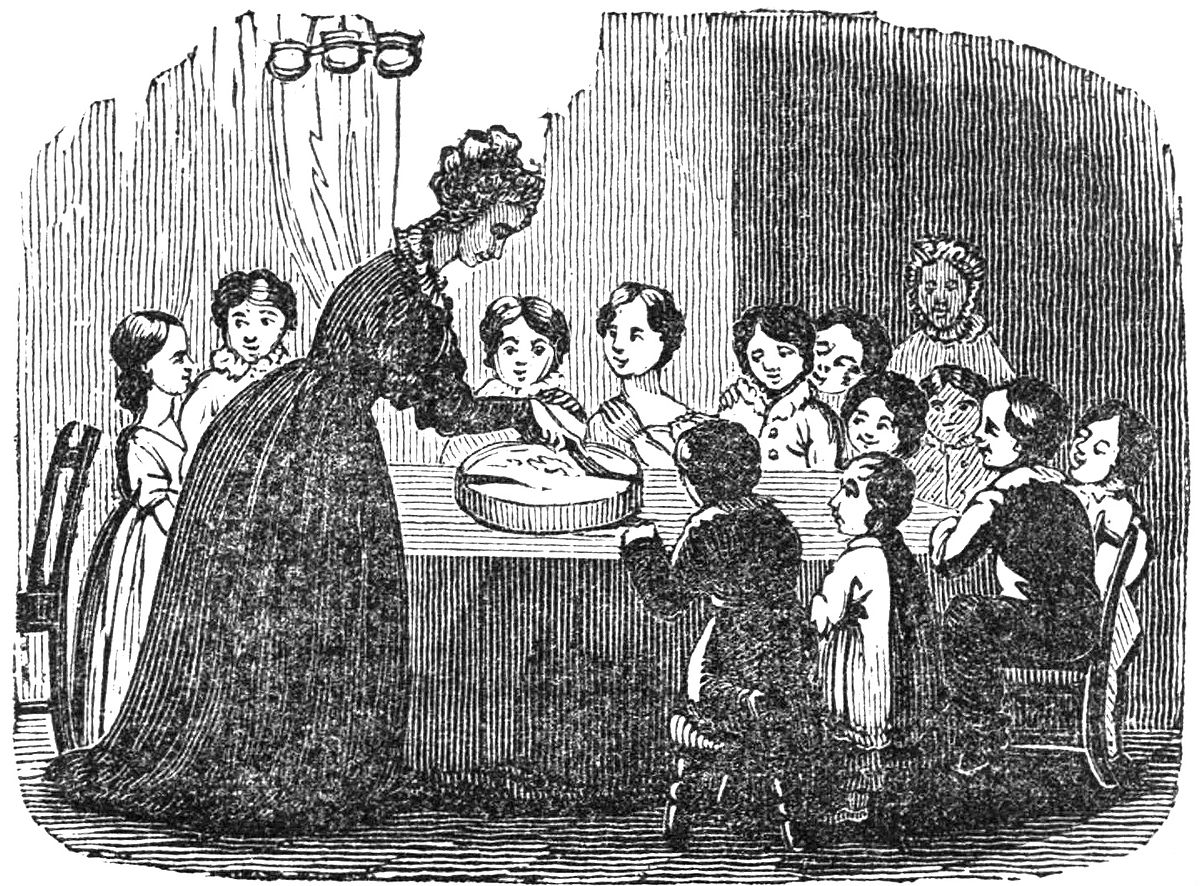
The whole “Twelve Days of Christmas” song comes from the twelve days between Christmas Day and January 6th (Epiphany). In the Regency, Christmas was more of a religious celebration but Twelfth Night (either January 5th or January 6th—no one seems to agree which “night” it is) was a party. They had Twelfth Night Cake or what we call “king cake” in New Orleans. There were parlor games and balls, and a good time was had by all. Maybe that’s why the last four days of the song are about lords leaping, ladies dancing, pipers piping, and drummers drumming. Partay!!
Twelfth Night
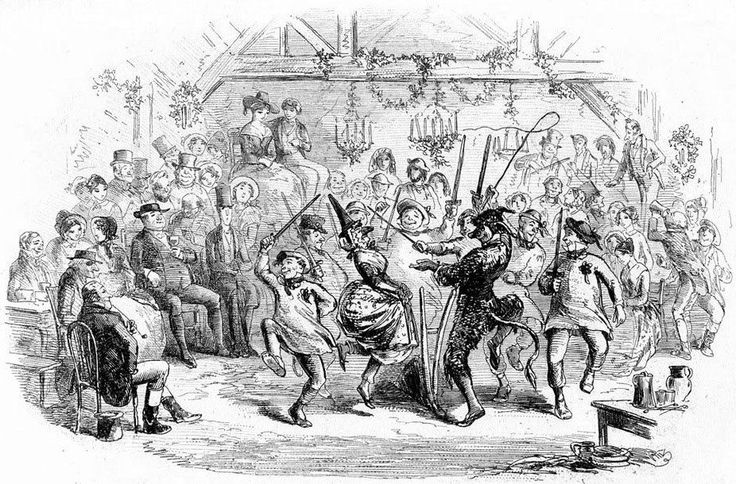
For Twelfth Night in Regency England, the custom of choosing a king and queen from whomever got the bean and pea in the twelfth-cake evolved into choosing characters out of a hat to pretend to be for the evening, a sort of masquerade. In some cases, they wore masks and the person was required to remain in character the entire night. Sounds like fun to me.
Twelfth Night – King Cake
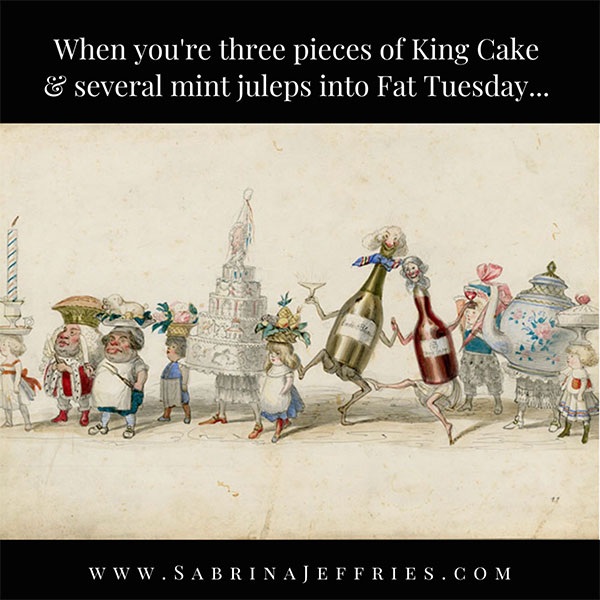
One Mardi Gras custom that New Orleanians have in common with the people of Regency England is that of the King Cake. In the Regency it was served on Twelfth Night (January 5th), the night before Epiphany (January 6th), but in New Orleans it’s served on Epiphany/Kings’ Day (or as it’s called in some Catholic countries, Three Kings’ Day, for the Three Wise Men). In both Regency England and modern-day New Orleans, the cakes have something hidden inside—a bean or a coin for Twelfth Night cakes and a plastic baby for King Cakes. If you get the slice of a Twelfth Night cake containing the bean or coin, you’re designated king for the party. If you get the baby in a New Orleans King Cake, you have to bring King Cake to the next party (in offices, someone generally brings a King Cake every Friday, and sometimes every day, beginning on January 6th and going until Mardi Gras!). After Mardi Gras comes Ash Wednesday, the beginning of Lent. As you might imagine, after living in New Orleans for years, I felt quite at home with Regency England’s celebration of Twelfth Night and Epiphany!
Boxing Day
The term “Boxing Day” actually shows up during our period, but the concept of giving a “box” to the poor or to those in service began much earlier, at least as far back as the Middle Ages. I read an account from the mid-18th century that described a man with a comfortable income giving anywhere from a shilling to a half-a-crown to servants and several merchants he had dealings with. On a large estate, the owner might give boxes of food and other gifts to each tenant and servant. It mirrors the American practice of offering Christmas gifts to public servants or business associates, except that in countries which practice it, it occurs the day AFTER Christmas.
Leisure Activities
Art
Artists
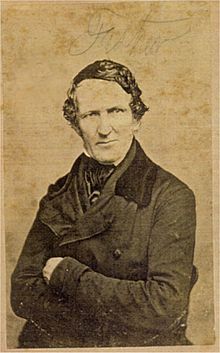
In researching The Art of Sinning, I discovered quite a few American artists who ended up touring or settling in England. The most famous one, of course, is Benjamin West, one of the founders of the Royal Academy of Arts. Already established as a portrait painter in Pennsylvania, he went to England initially for a visit and ended up residing there for the rest of his life. Alvan Fisher, an American landscapist, toured England around the time of my story. Samuel Morse (yes, the co-developer of Morse code) was also a painter and member of The Royal Academy, who studied in England under West. In fact, several American artists of the period studied there—Robert Fulton, Charles Wilson Peale, and Washington Allston, among others. So Jeremy was part of a long-standing tradition with American artists.
Comics
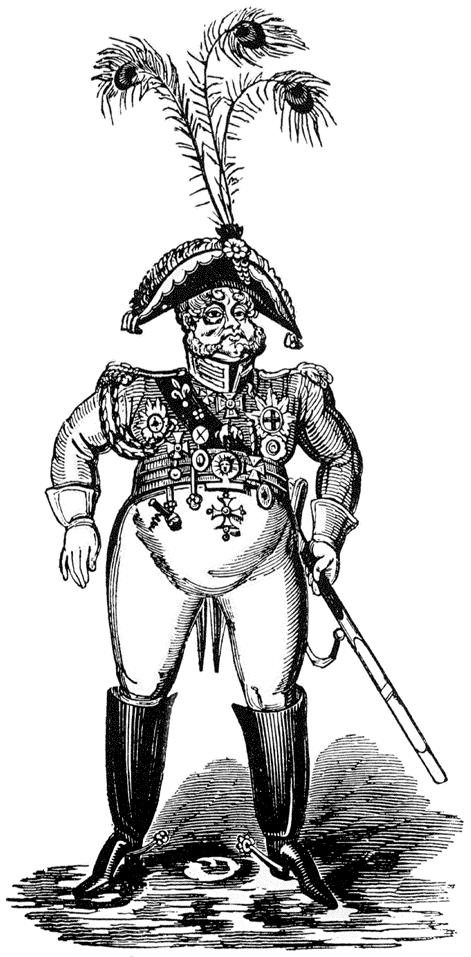
We tend to think of comics as modern, but the very first comics were humorous or satirical prints done by well-known artists like William Hogarth, James Gillray, and the Cruikshank brothers. The one I’ve included is of George IV (who was Prinny during our period). The caricaturists satirized him shamelessly, especially once he grew in girth. They were the first political cartoonists, but they didn’t limit themselves to political issues. Some of them just liked to poke fun at the rich and aristocratic. If you have time, check out their works online. Some of them were quite racy and amusing!
Remembering Family
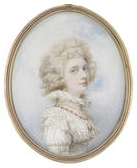
There was no photography in the Regency, so the only way you could capture your family’s images for all eternity was to have their portraits painted or their busts made. I was particularly moved by the bust of a young man commissioned by his family after his tragic death in his teens. They had no image of him to work from, so the artist did a likeness based on his siblings’ features and the descriptions of the family. Can you imagine having to endure your grief for a loved one without even being able to look at a picture of him? It really brought home to me how we take photographs for granted.
Books
Dictionaries
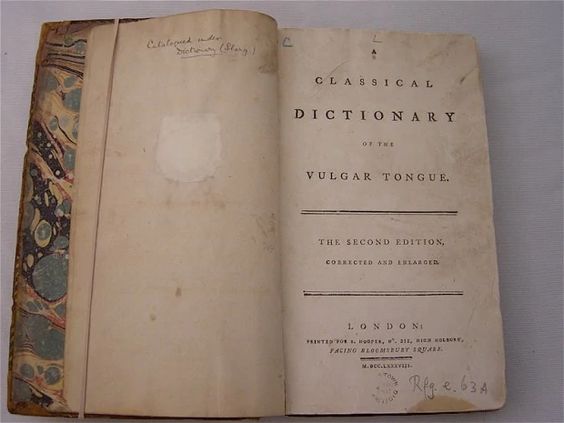
Yvette’s hobby of collecting slang is a bit out there, but it’s feasible. Regency women loved wordplay. If you read or saw the adaptation of Jane Austen’s Emma, you may remember Emma and Harriet collecting riddles and charades (word-puzzles) for a book. And slang dictionaries were more common than one would think. Captain Grose really did produce A Classical Dictionary of the Vulgar Tongue, and Pierce Egan really did have a book called Boxiana, with references to boxing slang. What’s more, one of the earliest female lexicographers I could find, Anna Brownlow Murphy, wrote a children’s dictionary that was published in 1814 and widely used in the Regency. It appeared in multiple editions. So why not a female lexicographer who collects slang?
Jane Austen Fans
Jane Austen had some lofty fans in her day, once word got around who she was. Prinny actually put her between a rock and hard place by having his librarian, J.S. Clarke, suggest that she dedicate her next book (Emma) to the Prince of Wales. Why was that so difficult? Because she couldn’t stand Prinny! Unfortunately, ignoring a royal dictate was unwise, so she did as he wished. But she put her foot down when Clarke then suggested that she write a historical romance about the ancestors of Prinny’s son-in-law. She explained that historical romance was not her cup of tea. Thank goodness, because I much prefer her stories of love in English villages.
But I’m happy I don’t have to revise books the way she did in the Regency. Authors did have pencils, erasers, paper, ink, and quill pens, but I hated revising when I had to retype things (before the advent of personal computers—yes, I was alive then), so imagine what it would be like to have to rewrite everything whenever you wanted to make a major revision. Handwriting was a crucial skill for clerks—there were even books on how to improve your business handwriting. All I can say is, thank heaven for computers.
Female Writers
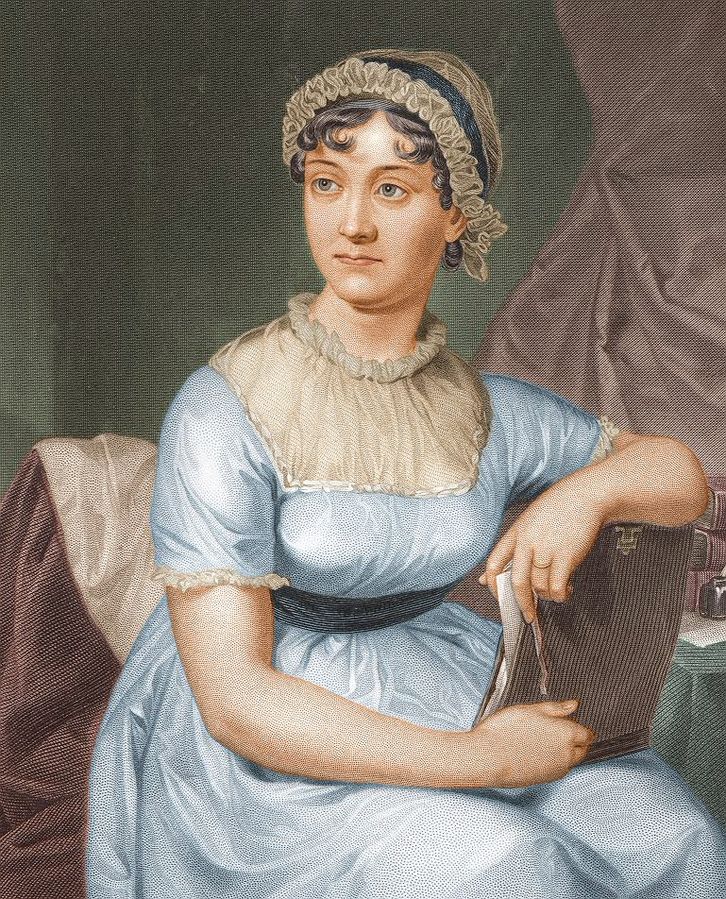
Many female writers in the 19th century took pseudonyms or wrote anonymously, because it was considered bad form for a lady or gentlewoman to write books. That’s why Jane Austen’s books were published anonymously as “By a Lady” or “By the Author of Pride and Prejudice,” etc. Charlotte, Anne, and Emily Bronte wrote as Currer, Acton, and Ellis Bell. Lady Caroline Lamb wrote Glenarvon about London society (and Lord Byron, her former lover) anonymously. Mary Ann Evans wrote as George Eliot. But there were several women who did use their own names: Ann Radcliffe, Mary Shelley, and Elizabeth Inchbald. It depended on how radical they were and what their place was in society.
Children’s Books

By the Regency, children’s books were starting to be more than educational or religious. This is when the first fairy tales appear in book form (Grimm’s Fairy Tales were first published in 1812 in Germany) and you start getting entertaining works like the ones I quote in Dance of Seduction. Of course, “entertaining” didn’t quite have the same meaning it does now. After all, even though the poem “Cock Robin” that Gabe reads in To Wed a Wild Lord is subtitled, “a pretty painted toy for either girl or boy: suited for all ages,” it’s about how Robin Redbreast dies and everyone mourns him.
Book Covers
Book covers were boring in the Regency; i.e., there weren’t any images on them. But there were lots of images in them. George Cruikshank did a thriving business in black and white etchings for books, notably the novels of Charles Dickens and Laurence Sterne. As you might imagine, color illustrations were prohibitive. In fact, books were pretty expensive, too, which is why private circulating libraries flourished, and why all those rich dukes and earls were the only ones with big libraries. To own a book was a mark of wealth. Thank goodness books are now much more readily available for everyone.
Dancing
Just Dance
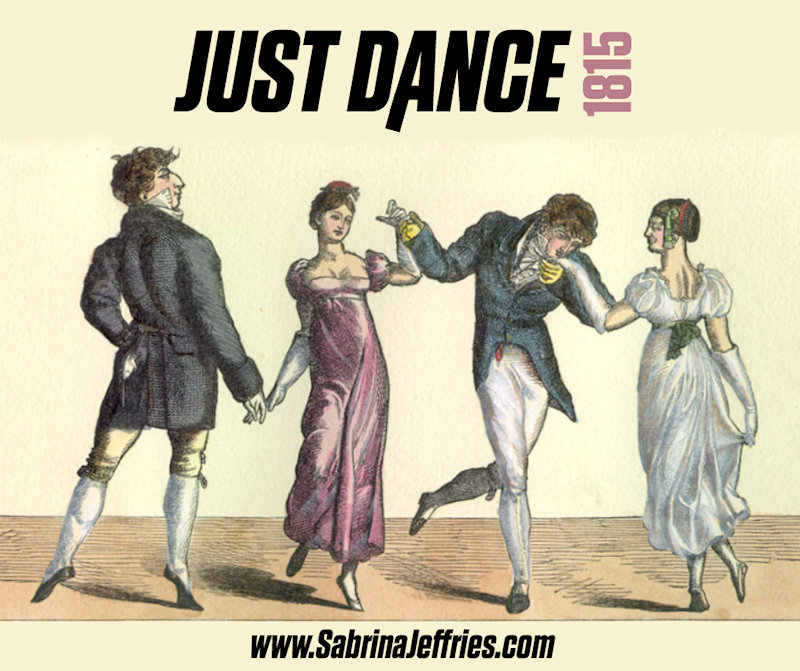
As I researched dances for Grey to teach Beatrice, I had trouble finding one with set figures for a specific piece of music. Although “Jenny’s Market” from Project Duchess was created specifically for the Emma BBC series, all of the figures can be found in a variety of English country dances, so I went with that one. Plus, it looked sexier than a lot of the others. Hey, just because I wanted a dance that was true to the period doesn’t mean I had to sacrifice intimacy to get it!
Masquerade Balls
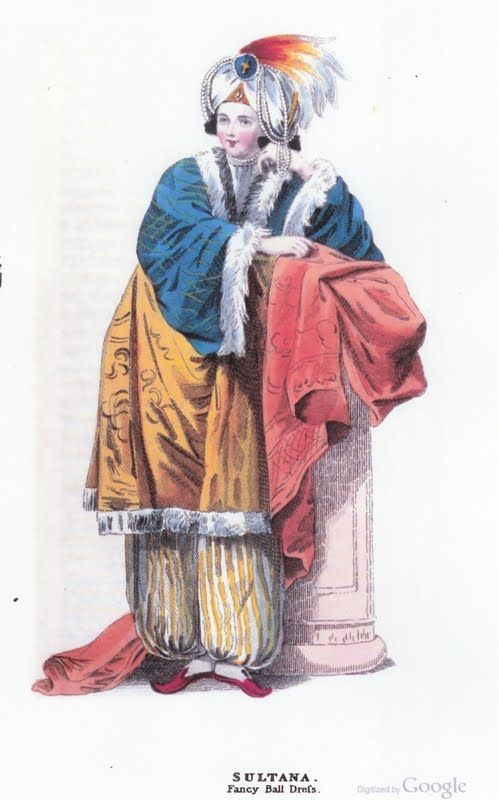
Masquerade balls were every bit as popular in the Regency as our romances lead us to believe. Just take a look at R. Ackermann’s Repository of Fashions for 1829. He includes several different costumes for “masquerade or fancy ball dress,” most of which are demure historical costumes for various centuries and one for a lavishly gowned “Sultana” (but sadly, no scantily clad houris). Although there are no masks in his pictures, there are plenty of mentions of masks in other period literature, so clearly they were sometimes worn. That’s a good thing, because it makes for great fun to have a hero unmask a heroine in our books.
The Season
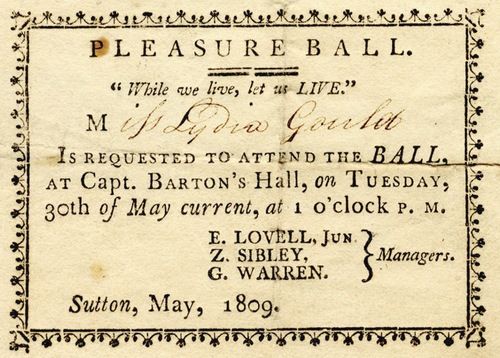
The “season” in London generally began officially after Easter, although some people were already in town for when Parliament opened in January. Imagine starting your day somewhere between mid-morning and noon, then going to pay calls, then riding on Rotten Row, then home to change and off to dinner somewhere, then perhaps to the theater, and then to a ball around ten p.m., where you danced until 3 a.m. or so. While that is exactly the kind of schedule I’m used to at conference, I can’t imagine doing it every day for a couple of months.
Fairs
Bartholomew Fair

Although some fairs had started to die out, some still provided popular entertainment in the Regency. You may have heard of Bartholomew Fair, which took place in London in September, or Scarborough Fair, which occurred in Scarborough, Yorkshire, around the same time (although it closed for good in 1788). Both were among a group of several “charter” fairs, established by Royal charter centuries before our period. Like most of them, they combined sales of things like cloth, rugs, or farm tools with entertainment like games, puppets, acrobats, rides, and dancing. You can see the swings in the image below. A few fairs still go on! So we’ll try to replicate one at the Historical Romance Retreat.
Gambling
Gaming Hells
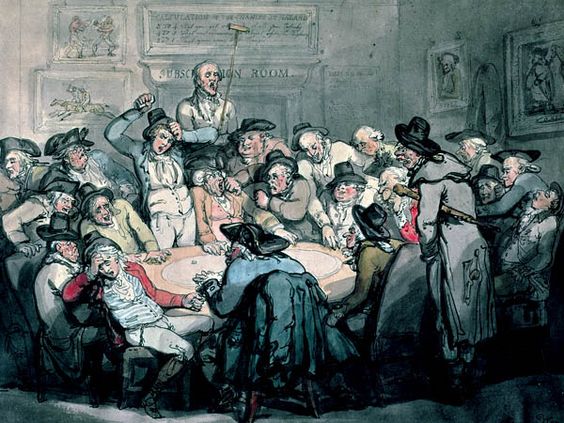
I did some writing while in Vegas, which was a surreal experience because Warren’s book involves gambling, and it definitely enhanced the writing experience to be in a city so dedicated to that. Most Regency bucks gambled primarily in private clubs (like St. George’s) or gaming hells. My book concerns the latter, since I wanted to have a sort of tavern/gaming hell combo where tavern maids served the men. I had to scour the internet for period descriptions and images of hells, which is how I was reminded of Crockford’s, a club run by a former fishmonger. Originally he worked in a gaming hell, and I found an excellent article at the Smithsonian magazine about it. It’s clear from the article that gaming hells were designed to cheat the customers at every turn. I guess we know why they were called hells! As usual, the house always wins, one way or the other.
Card Games
Regency folks loved card games, and many of those were either precursors to games we play now or are actually still being played. Whist, for example, became our present-day Bridge. Patience is our modern Solitaire, and Vingt-un (which is what the Brits called it; only the French called it Vingt-et-un) is actually our Blackjack. And Piquet (Warren and Delia’s game of choice) is still being played as it was centuries ago. In fact, the term carte blanche came directly from Piquet. It’s a very complicated game, so I haven’t attempted to master it, but you can find tutorials on the internet if that interests you.
Games
Apple Games
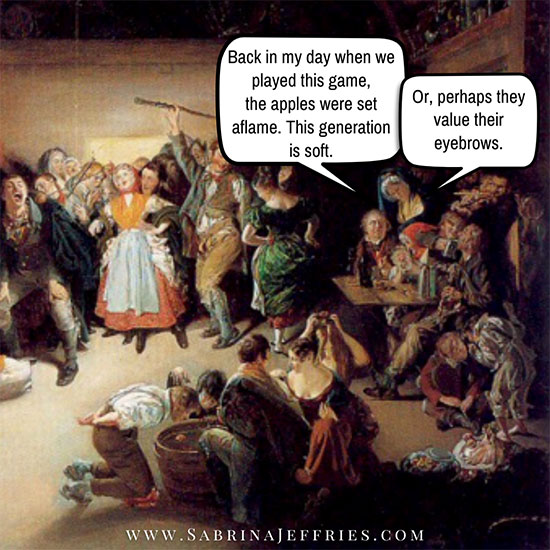
When I think of autumn and the Regency, I think of harvest fairs and harvest balls, brisk October winds, and lots of apples. But did you know that bobbing for apples was another of those romantic games where future romance was predicted? I didn’t, until I read this entertaining and thorough article about the origins of Halloween. Apparently, one variation was played the same way as it is now, except that names were carved into the apples so that whichever name was on the apple you seized was that of your future true love. Fortunately, the variation called “Snap-apple,” where a player had to seize the apple while it swung around on a pole with a burning candle at the other end of the pole, died out, or we’d not be enjoying trying to grab those apples quite so much!
Puzzles
Although the word “jigsaw” didn’t exist before the jig saw was invented in the late Victorian age, such puzzles did exist, cut out with marquetry saws. They were called “dissected maps.” Apparently, puzzles go back to the 1700’s, when they were primarily maps cut along the borders of the countries/counties, etc. You can see an example of two on my Pinterest page. I even saw them mentioned in a period account as a popular gift for loved ones on Valentine’s Day!
Raree Shows
Peep show boxes, otherwise known as Raree Shows, were a Regency form of entertainment typically meant for children. So I cheated a bit in Married to the Viscount by creating naughty ones. Or did I? I figured that since erotic material and images have been around since humans began recording such things, surely someone had created a naughty one. But in general, they were meant as amusements for people at fairs and such. A showman would use patter to describe the scenes as the viewers of all ages watched a progression of images go past on the “screen,” usually a painted backdrop that was moved or otherwise manipulated. I came up with the idea for including peep show boxes in my book when I saw two examples at a New York Public Library exhibit while I was on vacation. Yes, I am always looking out for stuff to use in my fiction.
Party Games
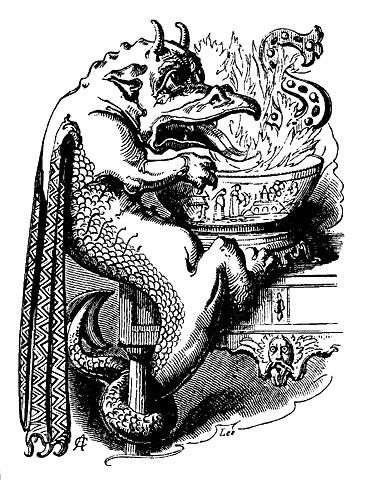
The Regency folks loved to party, too. And play party games. There was Bullet Pudding, which was essentially the same as Bobbing for Apples, except that players bobbed in a bowl of flour for a bullet. Yes, a real bullet. Those crazy kids! The fun was in seeing people end up covered in flour. And let’s not forget Blind Man’s Buff, in one version of which the blindfolded person tried to guess the identity of another by “feeling” their face. THAT one almost sounds scandalous!
They also played snapdragon, a crazy game where partygoers fished raisins out of a bowl of burning brandy. It actually dates back to Shakespeare’s time. It’s not as dangerous as it sounds, though. They used shallow bowls to make it easy to snatch the raisins and although the low blue flame seemed to put off lots of heat, the fire wasn’t deep and the brandy wasn’t that hot (I know because I’ve tried it). Our ancestors found it so entertaining that they even had a song to go with it.
Gardens
Regency Gardens

You were probably unaware that the study in Armitage House in London (Sheridan’s townhouse) looks out on a courtyard with a garden Sheridan stares at when he needs solace. The English have enjoyed gardening (and gardens) for centuries, to the extent that some of their landscape gardeners became celebrities. Lancelot “Capability” Brown comes to mind, although it was his successor, Humphry Repton, who coined the term “landscape gardener.” They were known for “creating” charmingly informal vistas, where there were fake ruins (which exist at Armitage Hall in the country), manufactured ponds and lakes, structured slopes, and ha-ha’s (hidden ditches that prevented animals from grazing near the house, essentially), all of it intended to look utterly natural. The style was popular for a century or more. If you want to be impressed, look up Capability Brown and you’ll discover the sheer volume of parks and gardens he designed in his lifetime. It has its own category on Wikipedia!
Gentlemen's Clubs
Gentlemen’s Clubs
Most people who are Regency era lovers know about the usual gentlemen’s clubs—White’s and Brooks. But there were far more than that, including some odd ones. Gentlemen’s clubs were for more than just gaming. Plenty of men also liked to hang out with other gentlemen who enjoyed similar interests. For example, the Beefsteak Club and Watier’s were founded for men who enjoyed a really good meal away from home. There was the Oriental Club for those who had traveled or resided in Asia. The Royal Society brimmed with scientists, philosophers, physicians, and other intellectual types. The Yacht Club served men who were interested in salt-water yachting. So St. George’s, a club for men concerned about protecting their women, isn’t too farfetched, I should think.
Music
Ballads

This has nothing to do with lipedema, but What Happens in the Ballroom (presently available on Kindle Unlimited, among other retail spots) has a scene where widow Eliza Harper Pierce sings several songs to entertain an audience. One of those, “The Suffolk Miracle,” is a ballad that Eliza uses to torment her papa (also in the audience) about a father who disapproves of his daughter marrying a man of a lower station. You can read the lyrics here, but I chose it by accident while looking for the ballad, “The Holland Handkerchief,” which I have on my folk albums. The two tell a nearly identical story, but “The Suffolk Miracle” is the title Eliza is likely to have heard for it. I happen to love ballads, and I learned long ago that most period ballads have multiple renditions, with variations in wording, title, and even ending. I only wish there was a version for this one with a happy ending!
Harp-Lute
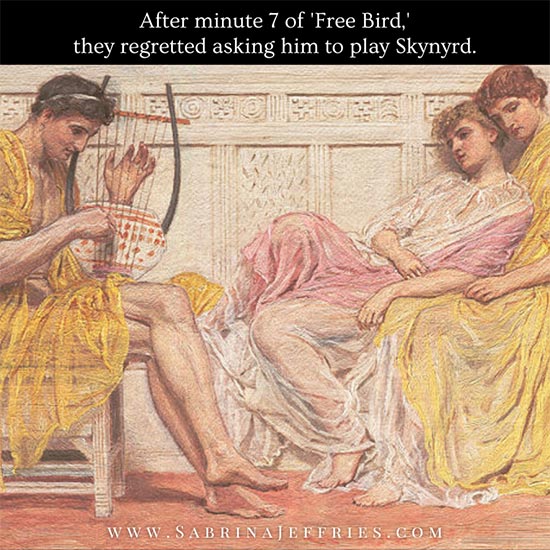
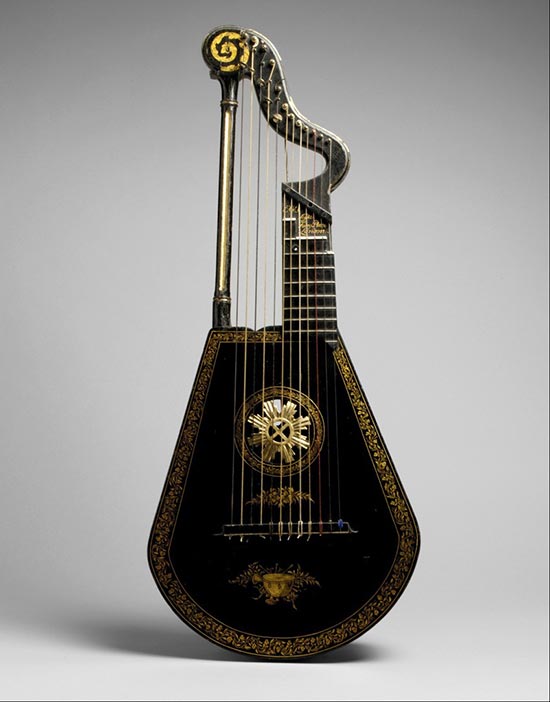
If you haven’t heard of a harp-lute, that’s because it was invented by Edward Light in 1795 and was briefly a sort of fad among young ladies in the Regency. Regency ladies liked it because they could accompany their singing with it. Once the piano replaced it as the instrument of choice for that, the harp-lute fell out of favor. There is still interest in it as part of the development of the guitar, though, and you can find a host of images here. Here’s an image of one in the Metropolitan Museum.
Glass Harp
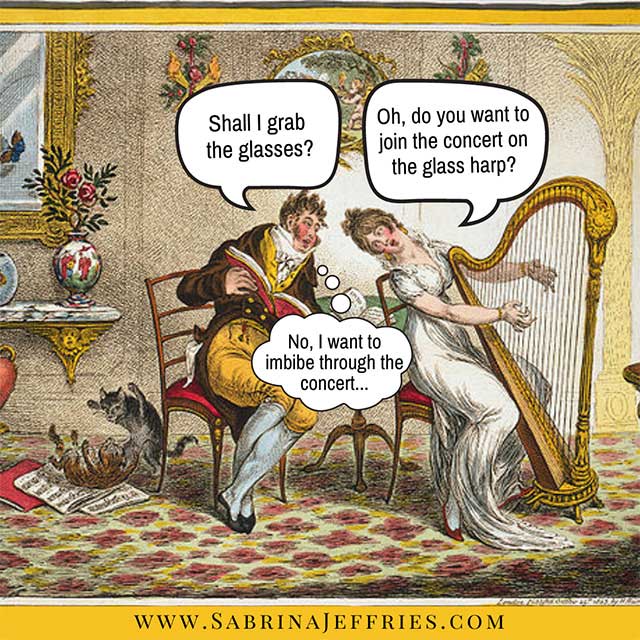
Here’s a fun addition to my A Yuletide Kiss story. To enhance the Christmas Eve celebration at the inn where he and the others are snowbound, Juncker plays an angelic organ, also known as a glass harp. The instrument was well-known by the time of the Regency, and consisted of several glasses (Juncker uses wine glasses) filled to different heights, so that when the harpist wets his finger and rubs it around the rims of the various glasses, it makes music (angelic music, I gather). Interestingly enough, the Brit who first mastered the instrument—an Irishman named Richard Pockrich—played his with sticks, which I would imagine created a slightly different sound. He played Handel’s “Water Music” on it (pun intended, ha ha)! Juncker settles for using his fingers. He doesn’t know how to put the sounds together to play actual songs, but he figures the melodious, random ringing will add to the festive air. And it does!
“Auld Lang Syne”
You probably know that “Auld Lang Syne” was written by Scottish poet Robert Burns, but you may not know that he was taking some of it from an older folk song. He’s the one who retooled it into its current version and popularized it in Scotland, and then, once he had it published, in England. Regency revelers sang his poem on New Year’s Eve just as we do, although it may not have been sung to the same tune. Still, it’s amazing how far back the sentiments go. One precursor to his poem that uses similar verses was published in 1711!
Outdoors
Birdwatching
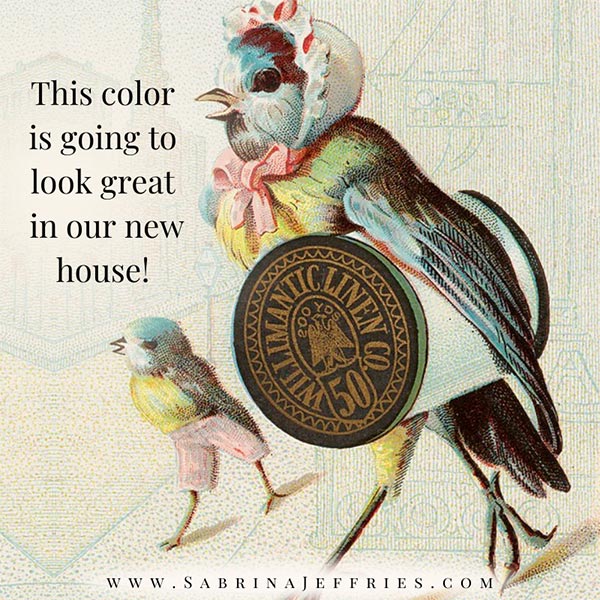
Y’all may or may not be aware that I’ve gotten into birdwatching from all my time spent writing on my deck. (I’d be there now except it’s all torn up as my husband gets it ready for spring.) That’s why I decided to give that hobby to Eliza. Also, Regency folks liked birds, too (no big surprise). I took her birdhouse from one that was actually from the period. Well, close to the period, anyway—1846. I had a hard time finding images earlier than the Victorian age, but the word “bird-seed” dates back to the 1700’s, and Regency era books abound for “bird-fanciers,” which tell you how to feed, house, rear, etc. birds of all types. Pet birds also appear in stories from the period. So I think I’m safe in saying Regency folks liked them!
Frost Fairs
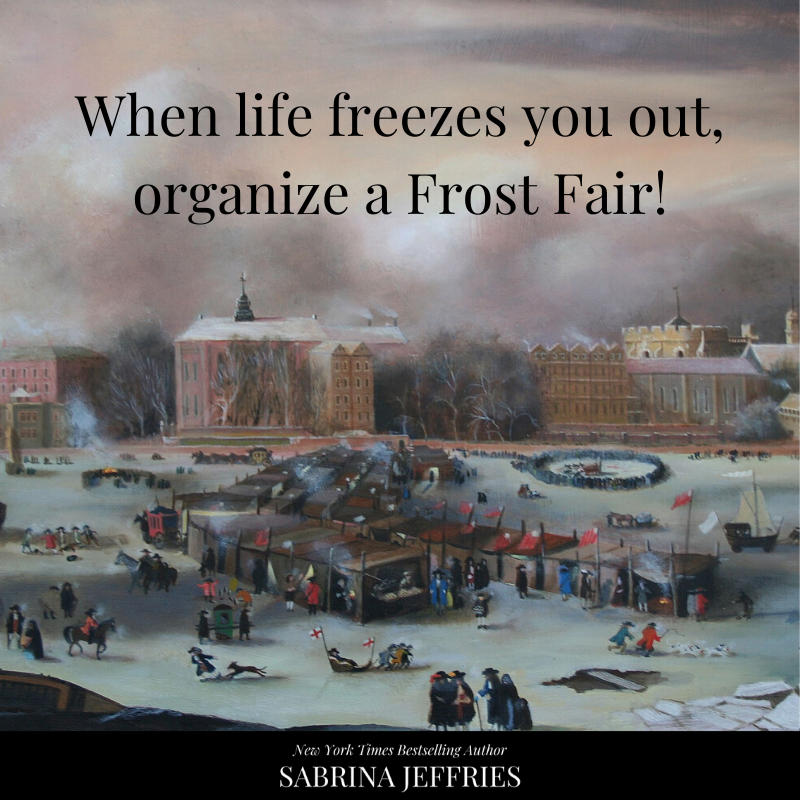
So, if you’re a fan of the Regency period, you’ve probably heard about the London Frost Fair of 1814, when the Thames froze for four days, and people set up fairground booths on the ice. They even led an elephant across! But you may not know why it happened. It was partly due to the Little Ice Age, which engulfed many parts of the world from around 1600 to 1850. Since seven possible causes have been postulated for why that happened, we won’t get into that. The upshot is that the Thames was wider and slower then, so the decrease in temperatures resulted in a number of frost fairs being held during those centuries. London Bridge also had more pilings that dammed up the river with ice in winter.
After 1814, the Thames never saw another Frost Fair. London Bridge was rebuilt with less pilings. The river was embanked, which helped it flow more freely. And the weather grew warmer. Don’t you wish you could have experienced a Frost Fair on the Thames? I do!
Prizefighting
Prizefighting
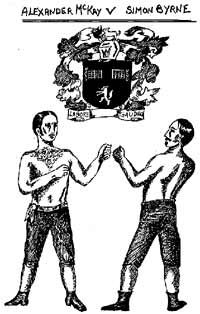
A love of boxing was pretty standard for young lords in the Regency. Since it was illegal to have pugilist matches, organizers had to resort to a great deal of subterfuge to arrange “mills,” as the events were called then, so he would have found that an enticing profession, since he’d been disinherited. A hundred years earlier, there were even matches for ladies, who fought bare-breasted. Though it sounds like the Georgian equivalent of the wet T-shirt contest, women boxers had supporters like any of the men and fought in major arenas. A woman named Elizabeth Wilkinson-Stokes even became quite famous for her abilities.
Racing and Riding
Horses of Regency
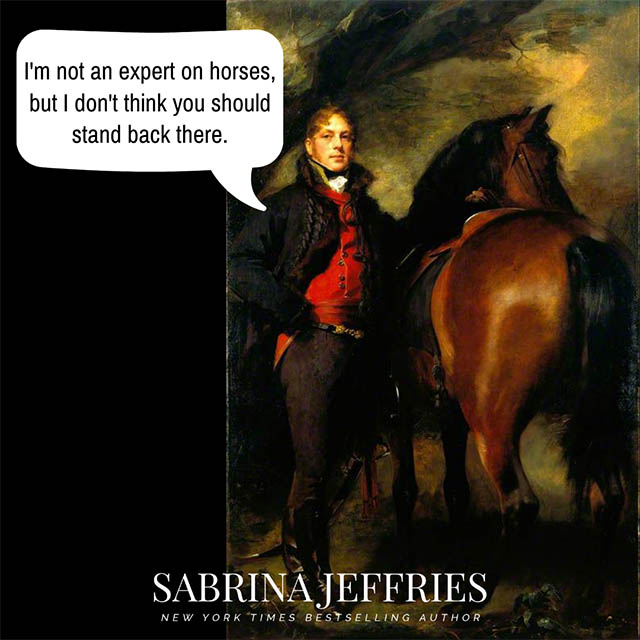
If you ride horses or deal with them regularly, you might already know the info in this tidbit (even so, you might find this more detailed article interesting. For the rest of you, here’s something you may not know. Horses were used in different capacities in the Regency. That’s why Sheridan considers raising money by selling some of his. A gentleman might have saddle horses for riding and carriage horses for pulling his carriage. A rich gentleman might also have Thoroughbreds for racing. Then, if their racing days are over, the owner might keep them for putting out to stud and charge stud fees. So Sheridan kept the moneymaking horses and (very sadly) sold some of the saddle horses.
Rotten Row
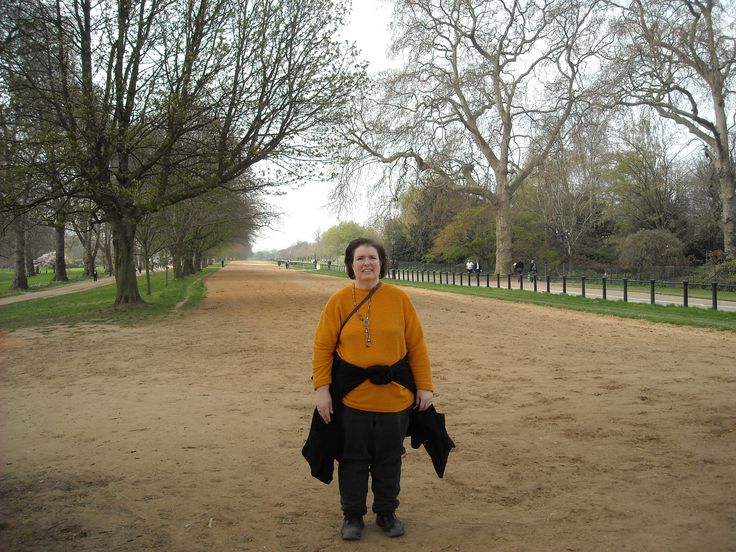
Rotten Row, where Jeremy Keane first meets Tristan in How the Scoundrel Seduces, was the favorite place for members of high society to ride, to see and be seen. I’d heard about it for years, so I was surprised when I visited Hyde Park a few years ago to find it nothing more than a dirt track stretching down the south end. It now serves as a place where horseback riders can exercise their mounts, but apparently isn’t used much even for that. According to the plaque on the site, it’s “the first lamp-lit road in the Kingdom,” which isn’t surprising, considering its connection to royalty. And speaking of royalty, that’s why it’s called “Rotten Row.” It’s a corruption of the French words for King’s Road—Rue de Roi.
Carriage Racing
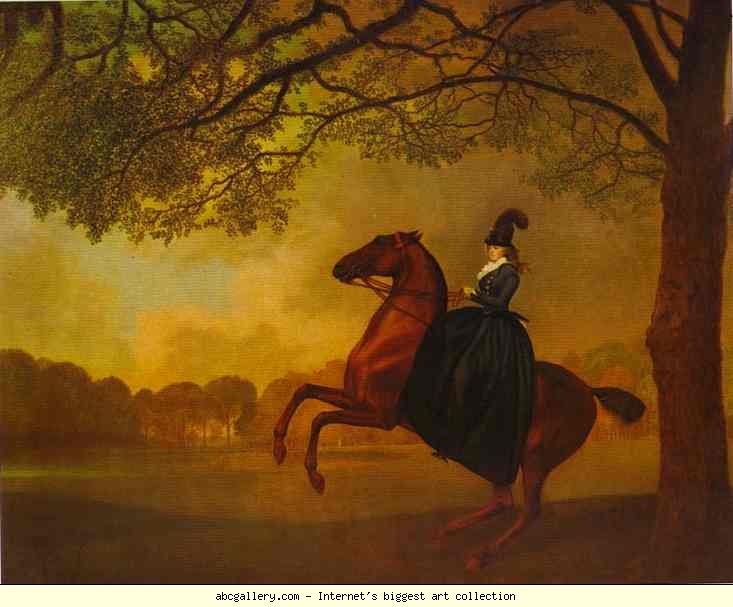
Carriage racing was also a popular pastime in Regency England. Think of it as being sort of like drag racing today—young men vying for who could drive the fastest rig. There were even a few famous female “whips” (as they called people who were mad about carriage racing): Lady Leticia Lade, Lady Archer, and Lady Stewart. With all the private races and the wagering that led to more and more dangerous ones, it’s a wonder any of them lived to a ripe old age.
Horses
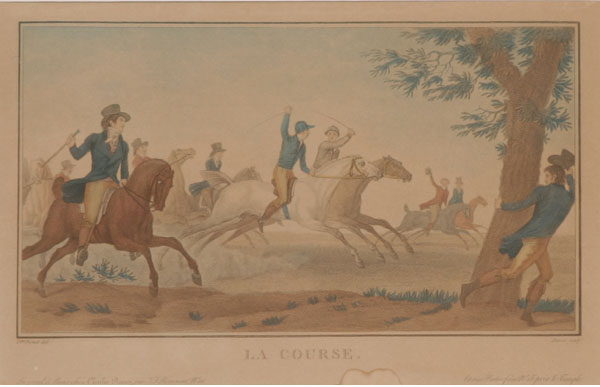
As you might imagine, everyone had horses in the Regency, especially the rich. And there was a whole group of people who wanted to race Thoroughbreds for fame and fortune (as Gabe wants to do). There were also people like Virginia Waverly and her grandfather, who ran stud farms to provide racing enthusiasts with new Thoroughbreds. It’s not much different from today—you could pay someone like the Waverly’s to have your mare “covered” by a famous race horse, and voila, you were on your way to success!
Scrapbooking
Scrapbooking

Women have been collecting pictures and gluing them into books since long before photos were invented. The practice began in England in the 16th century with “commonplace books,” which weren’t collections of pictures so much as recipes, formulas, bits of history. Later, with the advent of mass-produced prints, women would paste images or other memorabilia into “friendship albums” (I’ve got a pic of a page from one up on Pinterest). In fact, the word “scrapbook” came into usage in print in 1825, smack dab in the middle of when the Hellions series takes place. I even have one in my book Never Seduce a Scoundrel.
Sex
Timepieces
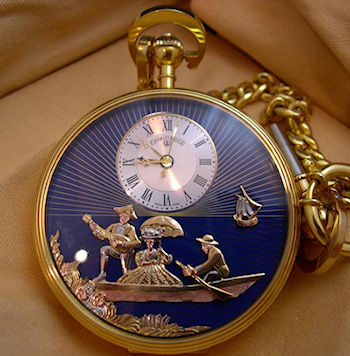
Believe it or not, I didn’t invent the erotic automaton watch in The Pleasures of Passion. They were popular throughout the late Regency and Victorian periods. Some even had two faces—the one that showed on the front with a sedate animated scene and the hidden one that was more erotic. This one, for example, has a much naughtier inside panel, but you could just enjoy the outside panel where the boat rocks, the servant rows the boat, and the gentleman plays the mandolin. Very clever. Can’t you just imagine certain young men carrying these sorts of watches, if only to provoke their relations?
Cyprians
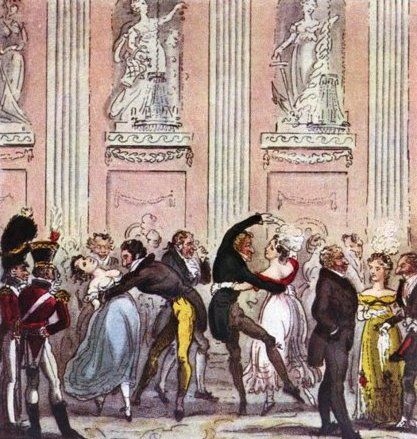
I admit it. I invented the widow’s auction that is the basis for my reissued novella, The Widow’s Auction. To my knowledge, no such auction ever occurred in a gentlemen’s club. But other similarly scandalous events took place. Like the Cyprian’s Ball held in the Argyll Rooms annually during the period. There’s even a famous print from the period depicting it.
A Cyprian was a courtesan, and the ball enabled women who couldn’t attend balls and society events normally to have their own where they could scope out potential protectors and vice-versa. So my auction is a bit of a variation on that, with masked respectable widows auctioning off their favors to gentlemen for one night. After all, why should courtesans have all the fun?
Illegitimate Children
Regency and Georgian men and women could be quite randy. The Duke of Queensbury had an illegitimate daughter, Mary, by an Italian marchesa (the equivalent of an English marchioness) and easily convinced an earl to marry his darling daughter. The founder of the Smithsonian Museum started life as the illegitimate son of the first Duke of Northumberland and a wealthy Bath widow. He was born abroad (discreetly) in Paris, and eventually brought back to England to be educated. William IV, Prinny’s youngest brother, had ten illegitimate children with an actress, all of whom were given titles or married off to lords. The higher in rank you were, the more your indiscretions were overlooked or swept under the table. But lower-ranking women could have a rough time. Many was the story of a fallen woman on the stage or in the brothels who’d been a gentlewoman before she was seduced. Which is why my club members are trying to keep the rogues at bay!
Shooting
Falconry
Although people were still writing and painting pictures about falconry (which primarily used hawks), it had just about died out as a pastime during the Regency because of the prevalence of guns in hunting (guns don’t have to be fed and trained, I suppose). By our period there was supposedly only one falconer left in all of England. But falconry was taken up by those crass Americans, and it was also still common in certain countries on the Continent. The English just preferred their rifles.
Female Markswomen
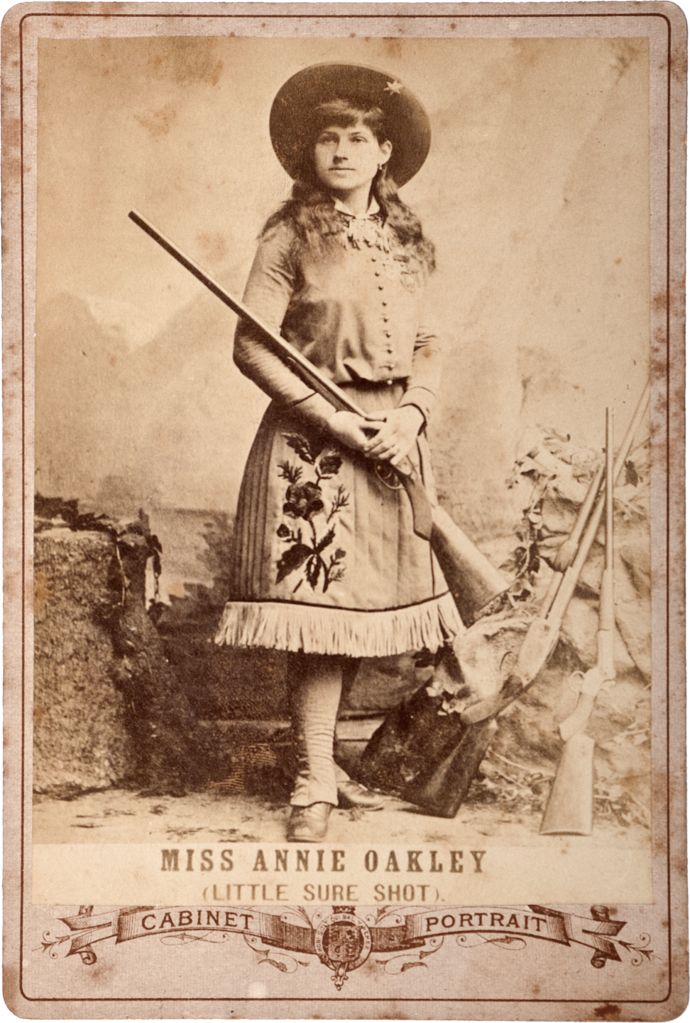
Annie Oakley wasn’t the earliest female markswoman. Long before she came along, there was Alice Ferree, a gunmaker’s wife in Pennsylvania, who tested all her husband’s rifles and was apparently a crack shot. And I suspect there were plenty of others we just don’t know about. The Regency was an interesting time for shooters, though. The cartridge had just been invented, so guns were in transition from flintlock to percussion. Though it took a while for percussion guns to catch on, after that there was no more muzzle-loading.
Speaking of Annie Oakley (who lived in the Victorian age, not the Regency), most people don’t know that the Buffalo Bill Wild West Show toured Europe four times between 1887 and 1892. It was even part of the celebration of Queen Victoria’s Golden Jubilee and was wildly successful, with 300 performances and ticket sales of two and half million (according to Wikipedia). Annie Oakley actually inspired me to write Celia Sharpe.
Theatre
Tom & Jerry
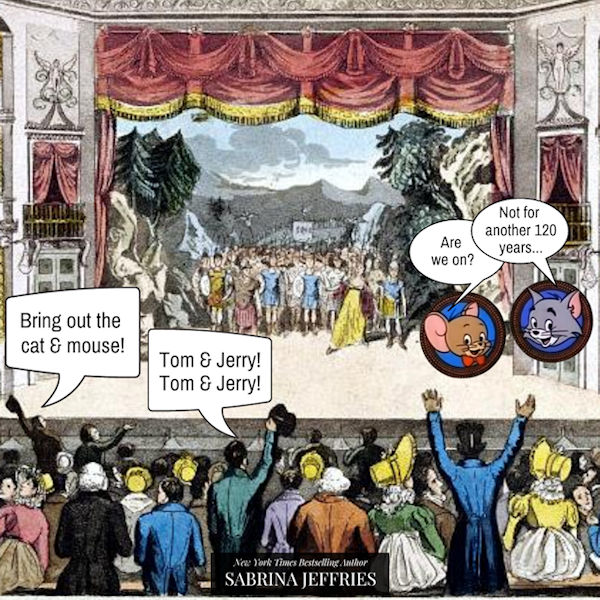
It’s not much of a spoiler to tell you that Thorn is secretly a playwright. But the plays he’s writing are loosely based on a novel by a man named Pierce Egan. Egan’s Life in London or, the Day and Night Scenes of Jerry Hawthorn, esq., and his elegant friend, Corinthian Tom, accompanied by Bob Logic, the Oxonian, in their rambles and sprees through the Metropolis spawned not only a theatrical adaptation (Tom and Jerry, or Life in London by William Thomas Moncrieffe), but had all of polite London society using the lowbrow slang of its characters. The Tom and Jerry cocktail created by Egan to publicize his work is still drunk by people who probably don’t even know where it originated. And the book was the inspiration for the Tom and Jerry cartoons more than a century later. How’s that for author longevity?
Lighting
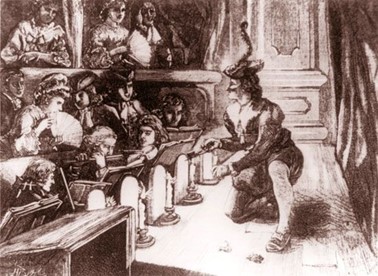
I learn something new every day. I don’t know why it didn’t occur to me before, but Regency era theaters were fully lit during the entirety of performances. There was no turning down of the lights, because the “house lights” were candles in sconces and chandeliers! Can you imagine lighting all those, and then blowing them all out, then lighting them again, etc.? It would take forever and be utterly impractical. As for the stage, they had foot lights, which were also candles but set in reflectors. Here’s a drawing I found of them on Pinterest. I collect tons of Regency era images on my various boards, so follow me on Pinterest so we can journey down the historical picture rabbit hole together!
Travel
Paris
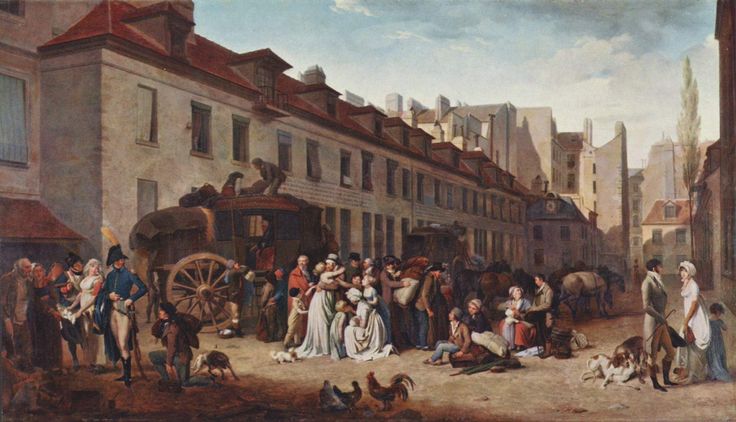
After the war ended, Regency ladies particularly enjoyed visiting Paris to check out the latest fashions. It was so common that daily trips were made by steam packet boats and diligences, a sort of omnibus coach where those willing to pay could travel more comfortably in the coach looking out a window than their less fortunate fellow passengers who were outside in the weather. Now we know where the idea of going first class comes from.
Travel
We are not the first generation to go touring other places for entertainment. The Lakes were a popular vacation destination for Regency travelers, but so was the Peak District, which lies mostly in Derbyshire. You may remember that when Lizzie expects to go to the Lakes for her vacation with the Gardiners in Pride and Prejudice, they have to go to the Peak District instead, which is how they end up seeing Pemberley (the stand-in for Pemberley’s outside scenes in the 2005 movie adaptation is the famous great house Chatsworth, which is also in the Peak District). Buxton, Derbyshire, was a spa town much like Bath, and there were caverns and other mountain beauties to explore in the district. One of these days I hope to visit it myself.
Miscellaneous
Somerset
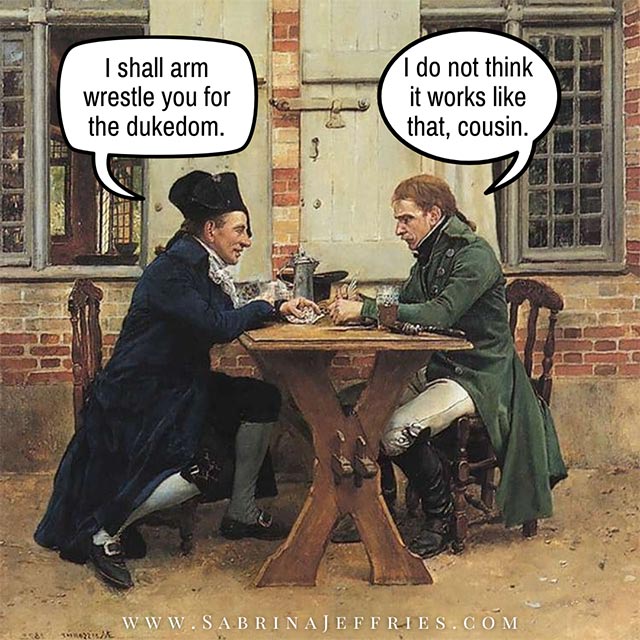
If you’re wondering how a man can inherit a dukedom from his distant cousin, take a look at the Duke of Somerset’s family tree (you’ll have to click “show”). The dukes of Somerset bounced all around that tree. The 8th duke was the great-great-great-great-great-grandson of the duke whose title was previously inherited by his distant cousin, the 7th duke. I think. My eyes started glazing over when I tried to figure out what cousin that would make them. Lots of removes. Look up primogeniture and you will understand why only certain males in the tree could inherit the dukedom. It’s fascinating stuff, but so complicated it makes me reluctant to tackle my own family tree, which isn’t nearly as illustrious. I’m pretty sure King Henry VIII is not one of my ancestors!
Bridgewater
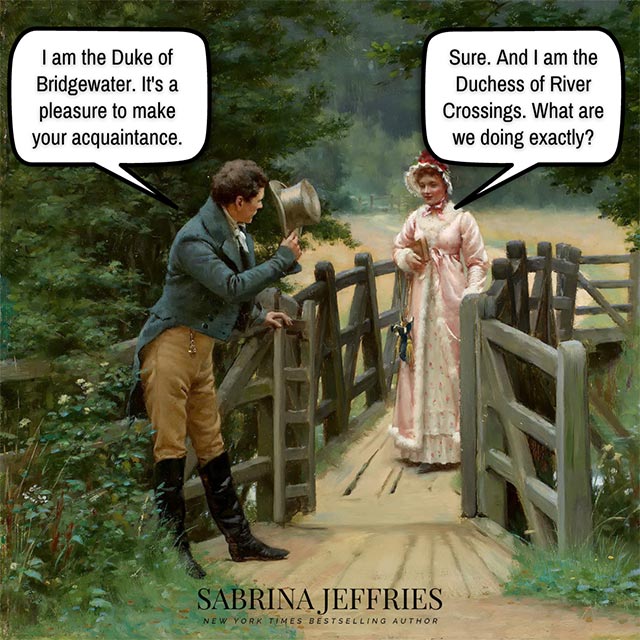
Geoffrey from A Duke for Diana is partly inspired by an actual duke who was responsible for countless canals in England: the Duke of Bridgewater (I kid you not—that was his name). He was dubbed the “Canal Duke” because he had so many of them built or expanded. Interestingly, he never married. He was engaged to the Dowager Duchess of Hamilton (the former Elizabeth Gunning, noted society beauty), but broke it off. The Dowager Duchess went on to become the wife of a marquess who became the Duke of Argyll (so she was married to two dukes and engaged to one), and she also gave birth to four dukes (only two dukedoms, though). Thus, SHE is the inspiration for Lydia, the mother of the three dukes in the Duke Dynasty series. Hey, I take my inspiration where I find it!
Business Ventures

A Duke for Diana’s Elegant Occasions isn’t as farfetched as you might think. Although it was frowned upon for aristocratic women to be “in trade,” certain types of business ventures were tolerated in such ladies. A well-known one was hiring oneself out to “sponsor” a young lady for her debut. Normally, a woman’s mother or other close relative presented her at the Queen’s drawing room for the first time. But what if the young lady is an orphan and all her female relations are dead or not interested? Then she could actually hire a respectable lady of rank to present her. I just chose to . . . expand the practice a bit. Of course, there were the usual impoverished ladies who became governesses or companions, but there were also ladies who supported themselves by designing for Wedgwood (Lady Templeton, Lady Diana Beauclerk), along with novelists (lots of those), artists (a surprising number of those), and even a sculptor or two. I stumble across them so often that I keep a list!
The Importance of Pencils
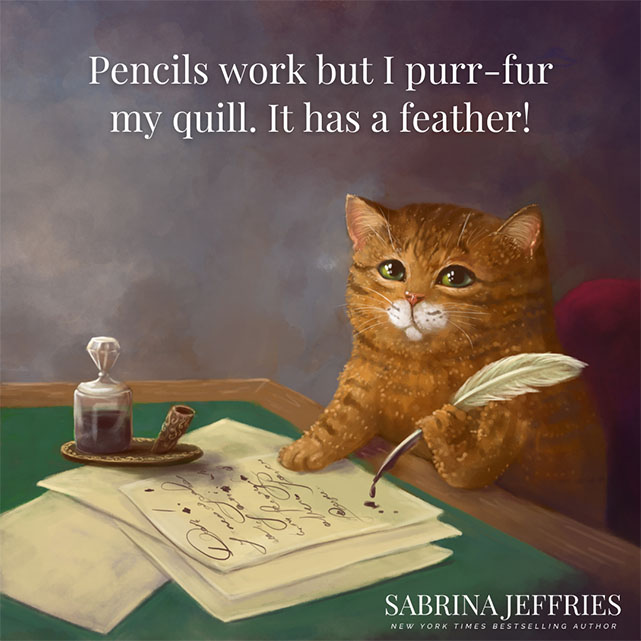
Today I’m going to talk about pencils, because the quill gets all the attention for Regency writing implements. But seriously, I had to do so much research to figure out why people lick the tips of pencils before they start writing (because I wanted my heroine to do it, naturally), that I figured I would fob some of my knowledge off on you. The answer to that question is complicated, but the fluid does make certain kinds of pencils write better. Anyway, you may already know that the writing part of pencils isn’t made of lead, but of graphite. The pencils in the Regency were probably from graphite sawn from a large deposit discovered in Cumbria, England, in the 1500’s. Pencils in England continued to be made from that deposit until the 1860’s. The pencils in Germany, however, were made from a mix of graphite powder and clay developed by a German at the end of the 1700’s. Fun fact: during the Napoleonic Wars, the French couldn’t get pencils from England or from Germany (both were their enemies), so a French officer in Napoleon’s army independently invented his own graphite powder and clay mixture to enable the French to have pencils. Who knew that pencils were so important?
Embalming

In honor of Halloween, I thought I’d talk about something rather grisly: embalming. Although it wasn’t popular in the Regency, the rich did tend to do it, especially since it enabled them to have open caskets for public funerals. So Olivia has a legitimate concern when she worries that if Grey’s father was embalmed, she might not be able to tell if he was poisoned. Every undertaker had different embalming methods at this time. How do I know? Because I stumbled across a very interesting source—Civil War era undertakers who shared their “recipes” for embalming fluid in The Era formulary: 5000 Formulas for Druggists! Most of the embalming ones contain arsenic in the form of arsenious acid. Eventually, formaldehyde replaced arsenic in embalming fluid, but that happened after the Civil War. You can find the entire formulary here.
Guns during Regency
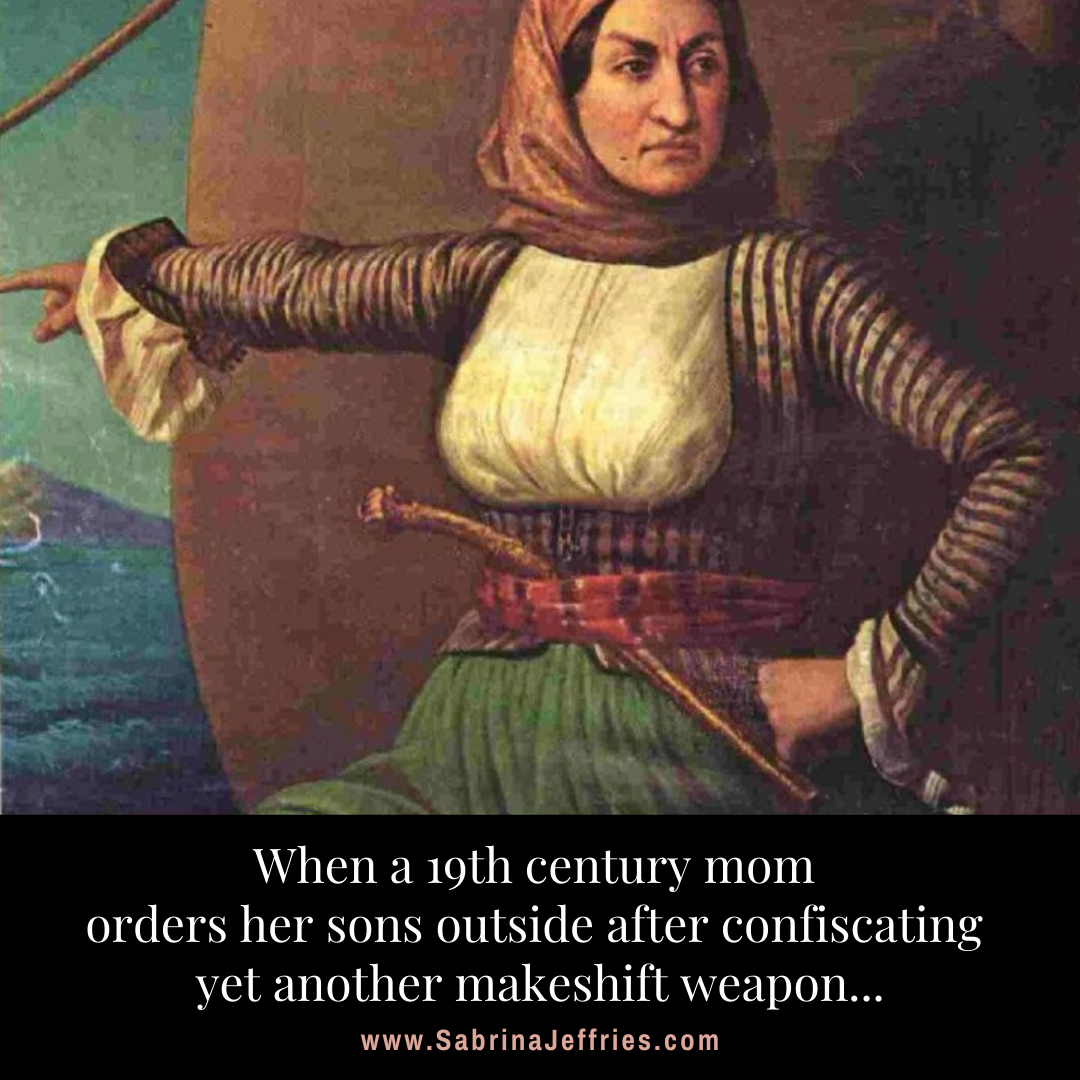
Guns during the Regency were sometimes things of beauty, like the one I describe in The Bachelor that Thorn offers to Joshua as payment for his being bodyguard to Gwyn. If you want to see what it looked like, I based it on an actual set of dueling pistols, a picture of which is on Pinterest here and here. I also have an image of Joshua’s seven-shot flintlock pepperbox pistol, made by Henry Nock of London around 1800, which looks big enough to use as a club after you run out of loaded barrels. Of course, it would take you a while to run through them all since the barrels had to be turned by hand! My Pinterest page for the book also features a number of blades in canes, pistol canes . . . everything you need to be a bodyguard.
Where did we get the term “Regency”?
Do you know where we get the term “Regency” for the period? (If you do, you can hum “God Save the Queen” while I explain.) It covers the time when the Prince of Wales, George Augustus Frederick (aka Prinny), stepped in as Regent for his father, King George III (aka the King George Americans fought against because of his taxation policies aka Mad King George), because he was, well, unable to run the country. So technically the Regency Period began in 1811 and ended in 1820, 200 years ago this month, when George III died and George IV became king. But for purposes of looking at periods in terms of their culture, fashions, ideas, etc., many people consider the Regency period to stretch from either 1783 or 1795 to 1830 or 1837 (when Victoria came to the throne). That’s why there’s such a wide range of dates in our books!
Crime
Eugène François Vidocq
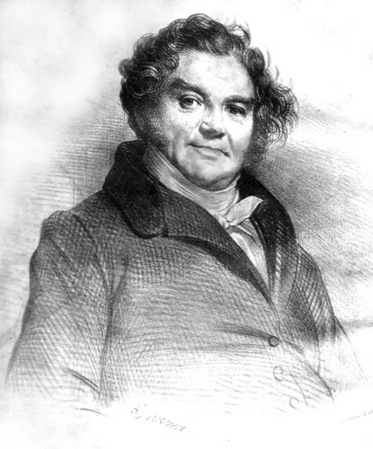
One of my favorite parts about writing What the Duke Desires was all the research I got to do into the life of Eugène François Vidocq, who appears as a character in the novel. What a fascinating fellow! Widely regarded as father of the private detective agency, he was a brilliant man who completely changed how crimes were investigated. He really did invent tamper-proof paper for banks as well as using ballistics for the first time to solve a crime. You can check out more pics of him on my Pinterest page.
Names
Invented Names
Several English Christian names were invented by authors. Shakespeare gave us Miranda, Jessica, Imogen, and Perdita. The poet Sir Philip Sydney gave us Pamela, and Jonathan Swift gave us Vanessa and Stella. Araminta was coined by William Congreve or Sir John Vanbrugh, who both managed to use it. From the period right before the Regency comes Fanny Burney’s Orville (trust me, I won’t be using that one anytime soon). The poet James MacPherson invented Fiona . . . and a whole series of ancient Scottish poems that were later discovered to be not so ancient (oops!). From the Regency period, we get Sir Walter Scott’s Cedric. Now that’s one I might use.
Names
Names like Minerva and Regina were popular in the Regency because of the fascination with everything classical—Greek architecture, Roman history, antiquities of all kinds. That’s why those early Regency gowns were so toga-like—they were influenced by the costumes that the English saw on Greek and Roman figures. The vertical lines, simple designs, and emphasis on white was a tribute to their love of classical sculpture.
The Press
The Press
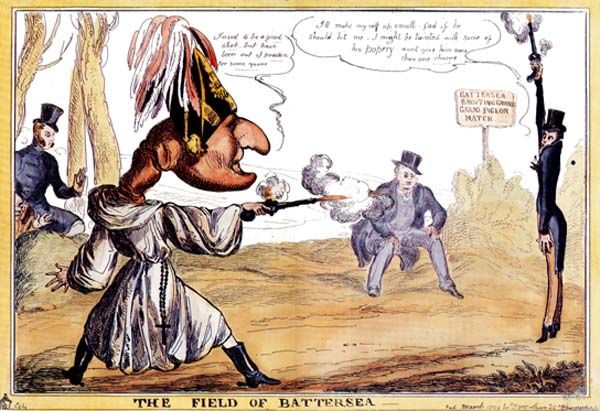
The press was as powerful a force in the Regency as it is now. Caricatures featuring “celebrities” like Prinny (George IV) and actresses and other luminaries were regularly displayed in shops, and gossip columns were rife with scandalmongers. Indeed, the Duke of Wellington was discussed in great detail and caricatured savagely after he fought a duel with the Earl of Winchilsea over politics, of all things, especially since Wellington deliberately fired wide and the earl fired in the air. Even the mighty Iron Duke couldn’t escape being pilloried in the press.
Titles
Titles
Most of the time, when you see a woman called the Countess of Whatever, it’s because she’s married to the Earl of Whatever. It’s called a “courtesy title.” Women gain courtesy titles by being married to men with titles (and children gain courtesy titles on behalf of their father . . . until the sons inherit the title). But once in a while, with Scottish or Irish titles or with titles going back centuries, the patent (the legal construct, if you will) for the title will allow for a woman to inherit. In those very rare cases, the Countess of Whatever inherits the title and estate from her father, the Earl of Whatever. She doesn’t have to marry anyone to get it. I love that.
Science
Embalming

In honor of Halloween, I thought I’d talk about something rather grisly: embalming. Although it wasn’t popular in the Regency, the rich did tend to do it, especially since it enabled them to have open caskets for public funerals. So Olivia has a legitimate concern when she worries that if Grey’s father was embalmed, she might not be able to tell if he was poisoned. Every undertaker had different embalming methods at this time. How do I know? Because I stumbled across a very interesting source—Civil War era undertakers who shared their “recipes” for embalming fluid in The Era formulary: 5000 Formulas for Druggists! Most of the embalming ones contain arsenic in the form of arsenious acid. Eventually, formaldehyde replaced arsenic in embalming fluid, but that happened after the Civil War. You can find the entire formulary here.
Chemistry
Early Chemists
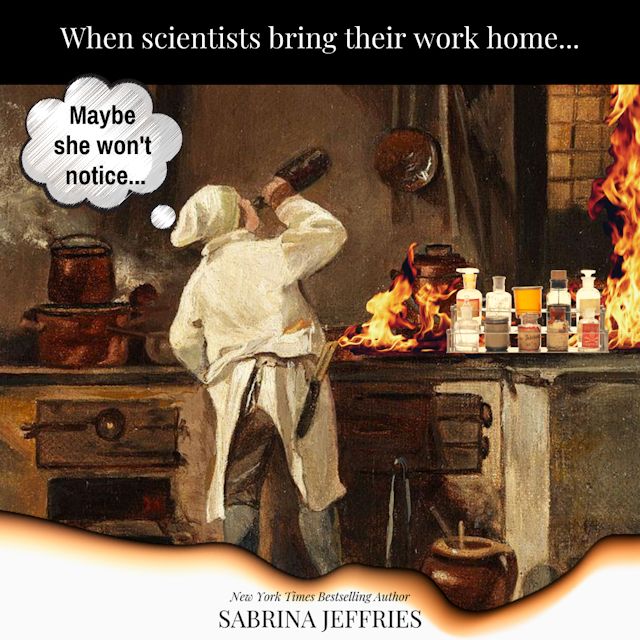
Beyond taking chemistry in college, I know very little about it, so I did a great deal of research for this particular book. I spent FAR too much time watching videos of experiments, but at least I got a direct sense of how certain chemicals reacted to each other. And I found some funny stories about early chemists. There was Christian Friedrich Schönbein (inventor of the fuel cell and guncotton and discoverer of ozone) who, in 1845, despite having promised his wife not to experiment in their kitchen, was doing so while she was away and used her apron to sop up a combo of nitric acid and sulfuric acid. Then he hung the apron over the stove to dry and it ignited and burned to ash so quickly that it seemed to vanish! I sure hope it wasn’t his wife’s favorite, although I can totally see Olivia doing something like that (accidentally, of course) to her husband’s nightshirt. Ooh, that could lead to some sexy times, couldn’t it?
A Female Chemist
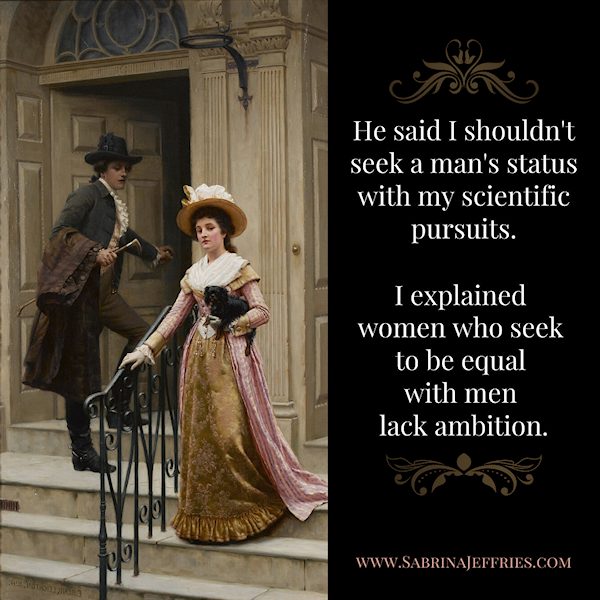
The heroine in my upcoming book, Who Wants to Marry a Duke, is a chemist. I based her on an actual female chemist from the period, the Scottish Mrs. Fulhame. Most people have never heard of her and we know little about her beyond the book she wrote detailing her experiments. Yet she published that critical work on her findings about catalysis long before any male chemist was credited with it, and she was lauded by a number of prominent chemists at the time, both in America and England. She even acknowledged that she expected some criticism from men over her work: “But censure is perhaps inevitable: for some are so ignorant, that they grow sullen and silent, and are chilled with horror at the sight of anything that nears the semblance of learning, in whatever shape it may appear; and should be the spectre appear in the shape of a woman, the pangs which they suffer are truly dismal.” Kudos to Mrs. Fulhame! We may not know the exact date of her birth, but she left her work behind to advance scientific discovery anyway. For that we can only be grateful. Go here to read more about her.
Soldiers & Spies
Officer Commissions
In both The Secret of Flirting and The Risk of Rogues I mention that Hart sold his commission. In case you don’t know what that means, during the Georgian, Regency, and partway through the Victorian periods, the British army (but not the British navy, apparently) used a system by which gentleman could buy a commissioned officer rank, beginning at cornet or ensign, and then purchase commissions to rise in rank (up to the rank of colonel). These commissions weren’t cheap, by any means (go to this page about officer’s commissions to see the costs). A commission as a cornet cost 450 pounds in 1837, which is equivalent to 38,000 pounds now ($50,473.88). And you can well imagine how much it cost to become a major. So Hart, a younger son of a rich marquess, could easily go up the ranks to captain. That’s why you always hear about younger sons of rich men going into the military. Once they decided to retire, they could sell their commissions for the total amount of money they spent and have a nice nest egg. That’s what Hart did. It’s more complicated than I’m making it sound (some regiments, like the Royal Artillery, used merit for advancement, and there were other restrictions), but this is the system in a nutshell. Now you know why some of those officers were so young (and incompetent).
Spies & Spycraft
The truth about spying in the Regency is we know little about it. I’ve seen raging debates on author websites in which authors both proclaimed it didn’t really exist and proclaimed the opposite (see the debate here). I would imagine that the point of having spies is not to have them be noticed. Ahem. Anyway, aside from the book mentioned in the comments of the debate, there is also The Man Who Broke Napoleon’s Codes about Sir George Scovell, who was knighted for breaking the French codes. Colquhoun Grant very famously sent intelligence to Wellington as he sneaked around Paris, having escaped his captors. There is some possibility that Mary Nesbitt, too, was a spy. As a courtesan and artist’s model who later became a merchant banker’s wife, she was supposedly sent to France during the Revolution to move in diplomatic circles and report back to English prime minister William Pitt. So, yes, there’s some evidence of spies. Enough for me to use in a book, anyway!

